|
(11) | EP 1 956 053 B1 |
| (12) | EUROPEAN PATENT SPECIFICATION |
|
|
| (54) |
Colorant compounds Farbstoffverbindungen Composés de colorants |
|
|
|||||||||||||||||||||||||||||||
| Note: Within nine months from the publication of the mention of the grant of the European patent, any person may give notice to the European Patent Office of opposition to the European patent granted. Notice of opposition shall be filed in a written reasoned statement. It shall not be deemed to have been filed until the opposition fee has been paid. (Art. 99(1) European Patent Convention). |
[0002] US-A-2008/0188662 entitled "Colorant Compounds" with the named inventor Jeffrey H. Banning, and US-A-2008/0187665 entitled "Phase Change Inks Containing Colorant Compounds," with the named inventor Jeffery H. Banning, disclose a phase change ink composition comprising a phase change ink carrier and a colorant compound of the formula
or
[0003] wherein R1, R2, R3, and R4 each, independently of the others, is (i) a hydrogen atom, (ii) an alkyl group, (iii) an aryl group, (iv) an arylalkyl group, or (v) an alkylaryl group, wherein R1 and R2 can be joined together to form a ring, wherein R3 and R4 can be joined together to form a ring, and wherein R1, R2, R3, and R4 can each be joined to a phenyl ring in the central structure; wherein a and b each, independently of the others, is an integer which is 0, 1, 2, or 3, wherein each R5, and R6 independently of the other, is (i) an alkyl group, (ii) an aryl group, (iii) an arylalkyl group, (iv) an alkylaryl group, (v) a halogen atom, (vi) an ester group, (vii) an amide group, (viii) a sulfone group, (ix) an amine group or ammonium group, (x) a nitrile group, (xi) a nitro group, (xii) a hydroxy group, (xiii) a cyano group, (xiv) a pyridine or pyridinium group, (xv) an ether group, (xvi) an aldehyde group, (xvii) a ketone group, (xviii) a carbonyl group, (xix) a thiocarbonyl group, (xx) a sulfate group, (xxi) a sulfide group, (xxii) a sulfoxide group, (xxiii) a phosphine or phosphonium group, (xxiv) a phosphate group, (xxv) a mercapto group, (xxvi) a nitroso group, (xxvii) an acyl group, (xxviii) an acid anhydride group, (xxix) an azide group, (xxx) an azo group, (xxxi) a cyanato group, (xxxii) an isocyanato group, (xxxiii) a thiocyanato group, (xxxiv) an isothiocyanato group, (xxxv) a urethane group, (xxxvi) a urea group, or (xxxvii) hydrogen, wherein R5 and R6 can each be joined to a phenyl ring in the central structure,
[0004] wherein R8, R9, and R10 each, independently of the other, is (i) a hydrogen atom, (ii) an alkyl group, (iii) an aryl group, (iv) an arylalkyl group, or (v) an alkylaryl group;
[0005] wherein R is (i) an alkyl group, (ii) an aryl group, (iii) an arylalkyl group, or (iv) an alkylaryl group, wherein R if an alkyl group has from about 1 to about 100 carbon atoms, or about 18 to about 33 carbon atoms, or about 30 carbon atoms, or about 50 carbon atoms, wherein R if an aryl group has from about 5 to about 20 carbon atoms, or about 6 carbon atoms or about 10 carbon atoms, wherein R if an alkylaryl group has from about 7 carbon atoms, or about 30 carbon atoms, or about 50 carbon atoms or about 100 carbon atoms, wherein R if an arylalkyl group has from about 7 carbon atoms, or about 30 carbon atoms, or about 50 carbon atoms, or about 100 carbon atoms, wherein in embodiments, R is a waxy chain, waxy as used herein meaning containing at least about 10 carbon atoms, or at least about 18 carbon atoms, or from about 18 to about 100 carbon atoms, or from about 18 to about 33 carbon atoms, wherein in embodiments R is C6H5 (phenyl), wherein in embodiments R is CH2CH2 (ethylene), wherein in embodiments R is OH, wherein in embodiments R is O-R (alkoxy), for example, in embodiments, R is O-CH3 (methoxy), wherein in embodiments R is OAc, wherein OAc refers to any acetate moiety, and wherein in embodiments R is a co-polymer of maleic anhydride;
[0006] wherein n is an integer which is about 1 to about 1000, or about 1 to about 20 or at least about 4, or at least about 12, or at least 50, and where m is an integer which is about 1 to about 1000, or about 1 to about 20, or at least about 4, or at least about 12, or at least about 50.
[0007] US-A-2008/0186372, entitled "Phase Change Inks Containing Colorant Compounds," with the named inventor Jeffery H. Banning discloses a phase change ink composition comprising a phase change ink carrier and a colorant compound of the formula
or
[0008] The present disclosure is generally related to colorant compounds. More specifically, the present disclosure is directed to colorant compounds particularly suitable for use in hot melt or phase change inks. One embodiment of the present disclosure is directed to a compound of the formula
or
[0009] wherein R1, R2, R3, and R4 each, independently of the others, is (i) a hydrogen atom, (ii) an alkyl group, (iii) an aryl group, (iv) an arylalkyl group, or (v) an alkylaryl group, wherein R1 and R2 can be joined together to form a ring, wherein R3 and R4 can be joined together to form a ring, and wherein R1, R2, R3, and R4 can each be joined to a phenyl ring in the central structure; wherein a and b each, independently of the others, is an integer which is 0, 1, 2, or 3,
[0010] wherein R5 and R6 are each optionally present and wherein each of R5 and R6 independently of the other, if present, are independently selected from (i) an alkyl group, (ii) an aryl group, (iii) an arylalkyl group, (iv) an alkylaryl group, (v) a halogen atom, (vi) an ester group, (vii) an amide group, (viii) a sulfone group, (ix) an amine group or ammonium group, (x) a nitrile group, (xi) a nitro group, (xii) a hydroxy group, (xiii) a cyano group, (xiv) a pyridine or pyridinium group, (xv) an ether group, (xvi) an aldehyde group, (xvii) a ketone group, (xviii) a carbonyl group, (xix) a thiocarbonyl group, (xx) a sulfate group, (xxi) a sulfide group, (xxii) a sulfoxide group, (xxiii) a phosphine or phosphonium group, (xxiv) a phosphate group, (xxv) a mercapto group, (xxvi) a nitroso group, (xxvii) an acyl group, (xxviii) an acid anhydride group, (xxix) an azide group, (xxx) an azo group, (xxxi) a cyanato group, (xxxii) an isocyanato group, (xxxiii) a thiocyanato group, (xxxiv) an isothiocyanato group, (xxxv) a urethane group, or (xxxvi) a urea group, wherein R5 and R6 can each be joined to a phenyl ring in the central structure, wherein
[0011] wherein R8, R9, and R10 each, independently of the other, is optionally present and wherein, if one or more are present, each of R8, R9, and R10 is independently selected from (i) a hydrogen atom, (ii) an alkyl group, (iii) an aryl group, (iv) an arylalkyl group, or (v) an alkylaryl group;
[0012] wherein in further embodiments, the number of carbon atoms in R1+R2+R3+R4+R5+R6+R8+R9+R10 is at least 4, or in another embodiment at least 16;
[0013] wherein R" is optionally present and wherein R' and R", if present, are each independently selected from (i) an alkyl group, (ii) an aryl group, (iii) an arylalkyl group, or (iv) an alkylaryl group, wherein R' or R" are independently selected from linear or branched, saturated or unsaturated, or cyclic components, wherein in embodiments, R' or R", if present, are independently selected from an alkyl group containing from 0 carbon atoms (that is, R" is 0) to 8 carbon atoms, from 1 carbon atom to 8 carbon atoms, or 12 carbon atoms, or 18 carbon atoms, or 30 carbon atoms, or 50 carbon atoms, or 100 carbon atoms, wherein in embodiments, R' or R", if present, are independently selected from an aryl group containing 5 carbon atoms, or 6 carbon atoms, or 10 carbon atoms, wherein in embodiments R' or R", if present, are independently an alkylaryl group or an arylalkyl group containing 7 carbon atoms, or 30 carbon atoms, or 50 carbon atoms; or 100 carbon atoms, wherein in one embodiment, R' contains 18 carbon atoms and R" is 0 carbon atoms; wherein A is an anion, and wherein CA is either a hydrogen atom or a cation.
[0014] In general, phase change inks (sometimes referred to as "hot melt inks") are in the solid phase at ambient temperature, but exist in the liquid phase at the elevated operating temperature of an ink jet printing device. At the jet operating temperature, droplets of liquid ink are ejected from the printing device and, when the ink droplets contact the surface of the recording substrate, either directly or via an intermediate heated transfer belt or drum, they quickly solidify to form a predetermined pattern of solidified ink drops. Phase change inks have also been used in other printing technologies, such as gravure printing, as disclosed in, for example, U.S. Patent 5,496,879 and German Patent Publications DE 4205636AL and DE 4205713AL.
[0015] Phase change inks for color printing typically comprise a phase change ink carrier composition which is combined with a phase change ink compatible colorant. In a specific embodiment, a series of colored phase change inks can be formed by combining ink carrier compositions with compatible subtractive primary colorants. The subtractive primary colored phase change inks can comprise four component dyes, namely, cyan, magenta, yellow and black, although the inks are not limited to these four colors. These subtractive primary colored inks can be formed by using a single dye or a mixture of dyes. For example, magenta can be obtained by using a mixture of Solvent Red Dyes or a composite black can be obtained by mixing several dyes. U.S. Patent 4,889,560, U.S. Patent 4,889,761, and U.S. Patent 5,372,852 teach that the subtractive primary colorants employed can comprise dyes from the classes of Color Index (C.I.) Solvent Dyes, Disperse Dyes, modified Acid and Direct Dyes, and Basic Dyes. The colorants can also include pigments, as disclosed in, for example, U.S. Patent 5,221,335. U.S. Patent 5,621,022 discloses the use of a specific class of polymeric dyes in phase change ink compositions.
[0016] Phase change inks have also been used for applications such as postal marking, industrial marking, and labeling.
[0017] Phase change inks are desirable for ink jet printers because they remain in a solid phase at room temperature during shipping, long term storage, and the like. In addition, the problems associated with nozzle clogging as a result of ink evaporation with liquid ink jet inks are largely eliminated, thereby improving the reliability of the ink jet printing. Further, in phase change ink jet printers wherein the ink droplets are applied directly onto the final recording substrate (for example, paper, transparency material, and the like), the droplets solidify immediately upon contact with the substrate, so that migration of ink along the printing medium is prevented and dot quality is improved.
[0018] Compositions suitable for use as phase change ink carrier compositions are known. Some representative examples of references disclosing such materials include U.S. Patent 3,653,932, U.S. Patent 4,390,369, U.S. Patent 4,484,948, U.S. Patent 4,684,956, U.S. Patent 4,851,045, U.S. Patent 4,889,560, U.S. Patent 5,006,170, U.S. Patent 5,151,120, U.S. Patent 5,372,852, U.S. Patent 5,496,879, European Patent Publication 0187352, European Patent Publication 0206286, German Patent Publication DE 4205636AL, German Patent Publication DE 4205713AL, and PCT Patent Application WO 94/04619. Suitable carrier materials can include paraffins, microcrystalline waxes, polyethylene waxes, ester waxes, fatty acids and other waxy materials, fatty amide containing materials, sulfonamide materials, resinous materials made from different natural sources (tall oil rosins and rosin esters, for example), and many synthetic resins, oligomers, polymers, and copolymers.
[0020] wherein X1 is an ester group or an amide group (such as of a carboxylic or sulfonic acid) or a fatty amine salt of a sulfonic acid, each X2 independently is a substituent, m has a value of from 0 to 2, Y1 and Y2 are each independently H, alkyl, or halo, each Z independently is an ester or amide group, and A- is an anion. The compound is useful as a colorant for toners, D2T2 printing, plastics, polyesters, nylons, and inks, especially ink jet or hot melt inks.
[0021] U.S. Patent 1,991,482 (Allemann) discloses a process of producing rhodamine dyes which comprises condensing a halogenated primary amine of the benzene series with fluorescein dichloride and sulfonating the condensed product.
[0022] U. S. Patent 5,013,857 (Berneth et al.) discloses a process for the preparation of sulpho-free triphenyl-methane dyestuffs.
[0023] U.S. Patent 5,847,162 (Lee et al.) discloses a class of 4,7-dichlororhodamine compounds useful as fluorescent dyes having the structure
[0024] wherein R1-R6 are hydrogen, fluorine, chlorine, lower alkyl lower alkene, lower alkyne, sulfonate, sulfone, amino, amido, nitrile, lower alkoxy, lining group, or combinations thereof or, when taken together, R1 and R6 is benzo, or, when taken together, R4 and R5 is benzo; Y1-Y4 are hydrogen or lower alkyl or, when taken together, Y1 and R2 is propano and Y2 and R1 is propano, or, when taken together, Y3 and R3 is propano and Y4 and R4 is propano; and X1-X3 taken separately are selected from the group consisting of hydrogen, chlorine, fluorine, lower alkyl carboxylate, sulfonic acid, -CH2OH, and linking group. In another aspect, the disclosure includes reagents labeled with the 4,7-dichlororhodamine dye compounds, including deoxynucleotides, dideoxynucleotides, and polynucleotides. In an additional aspect, the disclosure includes methods utilizing such dye compounds and reagents including dideoxy polynucleotide sequencing and fragment analysis methods.
[0025] U.S. Patent 4,935,059 (Mayer et al.) discloses basic rhodamine dyes suitable for use in recording fluids for the ink jet process and for coloring paper stock having the formula
[0026] where L is C2-C10-alkylene, R1, R2, and R3 are each independently of the others hydrogen, substituted or unsubstituted C1-C10-alkyl or C5-C7cycloalkyl or R1 and R2 together with the nitrogen atom linking them together are a hetero cyclic radical, An- is one equivalent of an anion and m and n are each independently of the other 0 or 1.
[0028] where A- is an anion, R is hydrogen or unsubstituted or substituted alkyl or cycloalkyl, R1 and R2 independently of one another are each hydrogen or unsubstituted or substituted alkyl or cycloalkyl, or one of the radicals may furthermore be aryl, or R1 and R2, together with the nitrogen atom, form a saturated heterocyclic structure, the radicals R3 independently of one another are each hydrogen or C1-C4 alkyl, R4 and R5 independently of one another are each unsubstituted or substituted alkyl or cycloalkyl, or one of the radicals may furthermore be hydrogen, aryl or hetaryl, R4 and R5, together with the nitrogen atom, form a saturated heterocyclic structure, n is 1, 2 or 3, X is hydrogen, chlorine, bromine, C1-C4-alkyl, C1-C4-alkoxy or nitro and Y is hydrogen or chlorine, are particularly useful for dyeing paper stocks.
[0030] U.S. Patent 1,981,516 (Kyrides) discloses intermediates for secondary alkylated rhodamine dyes.
[0031] British Patent Publication GB 421 737 discloses dyes of the rhodamine series which are prepared by condensing naphthalene-2:3-dicarboxylic acid with a m-aminophenol in which the nitrogen group is substituted by one or two alkyl groups, the products, if desired, being sulphonated. The unsulphonated products may be used as lake colouring matters whilst the sulphonated dyes are acid wool dyes. In examples, (1) naphthalene-2:3-dicarboxylic acid is condensed with diethyl-m-aminophenol in the presence of zinc chloride giving a product which dyes tannin-mordanted cotton in the same shade as Rhodamine B and a sulphonated product which dyes wool bluish-red shades; (2) monoethyl-m-aminophenol is used instead of the diethyl-m-aminophenol in example (1), yielding a dye, which when sulphonated dyes wool red-orange shades; (3) 2-ethylamino-p-cresol replaces the diethyl-m-aminophenol in example (1), yielding a dye dyeing and printing tannin-mordanted cotton in shades similar to Rhodamine 69BS and when sulphonated dyeing wool red.
[0033] wherein R1, R3 are each lower alkyl; R2 is lower alkyl, 10C or higher long-chain alkyl; R4 is 10C or higher long-chain alkyl; X- is an anion, or squarylium compounds of formula II
[0034] wherein R2 is 10C or higher long-chain alkyl. Example: 3,6-(N,N'-diethyl-N,N'-dioctadecyl) diamino-9-(2-carboxyphenyl) xanthilium perchlorate. Use: materials for molecular electronics, which are suitable for use as materials for photoelectric converter, optical memory, etc. Preparation: 2-(4-N,N'-diethylamino-2-hydroxybenzoyl)-benzoic acid, which is a condensate between N-ethyl-N-octadecyl-m-hydroxyaniline and phthalic anhydride, is reacted with N-ethyl-N-octadecyl-m-hydroxyaniline to obtain the compound of formula I. 3-HOC6H4N(Et)(CH2)17Me and phthalic anhydride were heated at 150° for 4 hours, treated with aqueous NH3, and the amorphous intermediate mixed with aqueous HClO4 forming a compound of formula I (R=R2=Et; R1=R3=C18H37; X=ClO4), having λmax (MeOH) 550 nm.
[0035] U.S. Patent 5,084,099 (Jaeger et al.) discloses modified phase change ink compatible colorants which comprise a phase change ink soluble complex of (a) a tertiary alkyl primary amine and (b) dye chromophores, i.e., materials that absorb light in the visible wavelength region to produce color having at least one pendant acid functional group in the free acid form (not the salt of that acid). These modified colorants are extremely useful in producing phase change inks when combined with a phase change ink carrier, even though the unmodified dye chromophores have limited solubility in the phase change ink carrier. Thin films of uniform thickness of the subject phase change ink compositions which employ the modified phase change ink colorants exhibit a high degree of lightness and chroma. The primary amine-dye chromophore complexes are soluble in the phase change ink carrier and exhibit excellent thermal stability.
[0036] U.S. Patent 5,507,864 (Jaeger et al.) discloses a phase change ink composition that includes a combination of different dye types such as an anthraquinone dye and a xanthene dye, which is most preferably a rhodamine dye. While each dye type is insufficiently soluble with respect to favored carrier compositions to preserve color saturation in reduced ink quantity prints, the dye type combination permits increased dye loading and maintains print quality. In a preferred embodiment of the disclosure, a favored carrier composition is adjusted to promote the colored form of a preferred rhodamine dye (C.I. Solvent Red 49) and mixed with a preferred anthraquinone dye (C.I. Solvent Red 172) whose concentration is kept below a critical level to prevent post printed blooming. The resulting preferred phase change ink compositions provide a magenta phase change ink with enhanced light fastness and color saturation, as well as good compatibility with preferred existing subtractive primary color phase change inks.
[0037] U.S. Patent 5,621,022 (Jaeger et al.) discloses a phase change ink composition wherein the ink composition utilizes polymeric dyes in combination with a selected phase change ink carrier composition.
[0038] U.S. Patent 5,747,554 (Sacripante et al.) discloses an ink composition comprising a polyesterified-dye (I) or polyurethane-dye (II) with a viscosity of from 3 centipoise to 20 centipoise at a temperature of from 125°C to 165°C and represented by the formulas
[0039] wherein A is an organic chromophore, Y is an oxyalkylene or poly(oxyalkylene), R is an arylene or alkylene, n represents the number of repeating segments, and is an integer of from 2 to 50, and p represents the number of chains per chromophore and is an integer of from 1 to 6.
[0040] U.S. Patent 5,902,841 (Jaeger et al.) discloses a phase change ink composition wherein the ink composition utilizes colorant in combination with a selected phase change ink carrier composition containing at least one hydroxyfunctional fatty amide compound.
[0041] European Patent Publication 0 565 798 (Shustack) discloses ultraviolet radiation-curable primary and secondary coating compositions for optical fibers. The primary coatings comprise a hydrocarbon polyol-based reactively terminated aliphatic urethane oligomer; a hydrocarbon monomer terminated with at least one end group capable of reacting with the terminus of the oligomer; and an optional photoinitiator. The secondary coatings comprise a polyester and/or polyether-based aliphatic urethane reactively terminated oligomer; a hydrocarbonaceous viscosity-adjusting component capable of reacting with the reactive terminus of (I); and an optional photoinitiator. Also disclosed are optical fibers coated with the secondary coating alone or with the primary and secondary coatings of the disclosure.
[0042] US-A-2005/0011411 of Jeffrey H. Banning et al., and U. S. Patent 6,860,931 of Jeffrey H. Banning et al. disclose in embodiments compounds of the formulae
and
[0043] wherein R1, R2, R3, and R4 each, independently of the others, is (i) a hydrogen atom, (ii) an alkyl group, (iii) an aryl group, (iv) an arylalkyl group, or (v) an alkylaryl group, wherein R1 and R2 can be joined together to form a ring, wherein R3 and R4 can be joined together to form a ring, and wherein R1, R2, R3, and R4 can each be joined to a phenyl ring in the central structure, a and b each, independently of the others, is an integer which is 0, 1, 2, or 3, c is an integer which is 0, 1, 2, 3, or 4, each R5, R6, and R7, independently of the others, is (i) an alkyl group, (ii) an aryl group, (iii) an arylalkyl group, (iv) an alkylaryl group, (v) a halogen atom, (vi) an ester group, (vii) an amide group, (viii) a sulfone group, (ix) an amine group or ammonium group, (x) a nitrile group, (xi) a nitro group, (xii) a hydroxy group, (xiii) a cyano group, (xiv) a pyridine or pyridinium group, (xv) an ether group, (xvi) an aldehyde group, (xvii) a ketone group, (xviii) a carbonyl group, (xix) a thiocarbonyl group, (xx) a sulfate group, (xxi) a sulfide group, (xxii) a sulfoxide group, (xxiii) a phosphine or phosphonium group, (xxiv) a phosphate group, (xxv) a mercapto group, (xxvi) a nitroso group, (xxvii) an acyl group, (xxviii) an acid anhydride group, (xxix) an azide group, (xxx) an azo group, (xxxi) a cyanato group, (xxxii) an isocyanato group, (xxxiii) a thiocyanato group, (xxxiv) an isothiocyanato group, (xxxv) a urethane group, or (xxxvi) a urea group, wherein R5, R6, and R7 can each be joined to a phenyl ring in the central structure,
[0044] R8, R9, and R10 each, independently of the others, is (i) a hydrogen atom, (ii) an alkyl group, (iii) an aryl group, (iv) an arylalkyl group, or (v) an alkylaryl group, provided that the number of carbon atoms in R1+R2+R3+R4+R5+R6+R7+R8+R9+R10 is at least about 16, each Q, independently of the others, is a COOH group or a SO3H group, each Q-, independently of the others, is a COO- group or a SO3- group, d is an integer which is 1, 2, 3, 4, or 5, A is an anion, and CA is either a hydrogen atom or a cation associated with all but one of the Q- groups, provided that when
[0045] at least one of the following of (a), (b), and (c) is true: (a) the number of carbon atoms in R1+R2+R3+R4 is at least about 42, (b) at least one of R1, R2, R3, and R4 is a group of the formula
[0046] wherein R41 and R42 each, independently of the other, is an alkyl group, an aryl group, an arylalkyl group, or an alkylaryl group, or (c) at least one of R1, R2, R3, and R4 is a branched alkyl group having at least about 19 carbon atoms.
[0047] While known compositions and processes are suitable for their intended purposes, a need remains for new magenta colorant compositions. In addition, a need remains for magenta colorant compositions particularly suitable for use in phase change inks. Further, a need remains for magenta colorants with desirable thermal stability. Additionally, a need remains for magenta colorants that exhibit minimal undesirable discoloration when exposed to elevated temperatures. There is also a need for magenta colorants that exhibit a desirable brilliance. In addition, there is a need for magenta colorants that exhibit a desirable hue. Further, there is a need for magenta colorants that are of desirable chroma. Additionally, there is a need for magenta colorants that have desirably high lightfastness characteristics. A need also remains for magenta colorants that have a desirably pleasing color. In addition, a need remains for magenta colorants that exhibit desirable solubility characteristics in phase change ink carrier compositions. Further, a need remains for magenta colorants that enable phase change inks to be jetted at temperatures of over 135 °C while maintaining thermal stability. Further, a need remains for magenta colorants for use in solid ink printers that operate with lower print head temperatures much lower than 135 °C as well as in ultraviolet radiation curable systems. Additionally, a need remains for magenta colorants that enable phase change inks that generate images with low pile height. There is also a need for magenta colorants that enable phase change inks that generate images that approach lithographic thin image quality. In addition, there is a need for magenta colorants that exhibit oxidative stability. Further, there is a need for magenta colorants that do not precipitate from phase change ink carriers. Additionally, there is a need for magenta colorants that do not, when included in phase change inks, diffuse into adjacently printed inks of different colors. A need also remains for magenta colorants that do not leach from media such as phase change ink carriers into tape adhesives, paper, or the like. In addition, a need remains for magenta colorants that, when incorporated into phase change inks, do not lead to clogging of a phase change ink jet printhead. Further, there is a need for magenta colorants that enable phase change inks that generate images with sharp edges that remain sharp over time. Additionally, there is a need for magenta colorants that enable phase change inks that generate images which retain their high image quality in warm climates. Further, there is a need for magenta colorants that enable phase change inks that generate images of desirably high optical density. Additionally, there is a need for magenta colorants that, because of their good solubility in phase change ink carriers, enable the generation of images of low pile height without the loss of desirably high optical density. A need also remains for magenta colorants that enable cost-effective inks.
[0048] The appropriate components and process aspects of the each of the foregoing may be selected for the present disclosure in embodiments thereof.
SUMMARY
[0049] The present invention provides:
- (1) A compound of the formula
wherein R1, R2, R3, and R4 each, independently of the others, is (i) a hydrogen atom, (ii) an alkyl group, (iii) an aryl group, (iv) an arylalkyl group, or (v) an alkylaryl group, wherein R1 and R2 can be joined together to form a ring, wherein R3 and R4 can be joined together to form a ring, and wherein R1, R2, R3, and R4 can each be joined to a phenyl ring in the central structure; wherein a and b each, independently of the others, is an integer which is 0, 1, 2, or 3;
wherein R5 and R6 are each optionally present and wherein each of R5 and R6 independently of the other, if present, are independently selected from (i) an alkyl group, (ii) an aryl group, (iii) an arylalkyl group, (iv) an alkylaryl group, (v) a halogen atom, (vi) an ester group, (vii) an amide group, (viii) a sulfone group, (ix) an amine group or ammonium group, (x) a nitrile group, (xi) a nitro group, (xii) a hydroxy group, (xiii) a cyano group, (xiv) a pyridine or pyridinium group, (xv) an ether group, (xvi) an aldehyde group, (xvii) a ketone group, (xviii) a carbonyl group, (xix) a thiocarbonyl group, (xx) a sulfate group, (xxi) a sulfide group, (xxii) a sulfoxide group, (xxiii) a phosphine or phosphonium group, (xxiv) a phosphate group, (xxv) a mercapto group, (xxvi) a nitroso group, (xxvii) an acyl group, (xxviii) an acid anhydride group, (xxix) an azide group, (xxx) an azo group, (xxxi) a cyanato group, (xxxii) an isocyanato group, (xxxiii) a thiocyanato group, (xxxiv) an isothiocyanato group, (xxxv) a urethane group, or (xxxvi) a urea group, wherein R5 and R6 can each be joined to a phenyl ring in the central structure,
wherein
is
or
wherein R8, R9, and R10 each, independently of the other, is optionally present and wherein each of R8, R9, and R10, if present, is independently selected from (i) a hydrogen atom, (ii) an alkyl group, (iii) an aryl group, (iv) an arylalkyl group, or (v) an alkylaryl group;
wherein R" is optionally present and wherein R' and R", if present, are each independently selected from (i) an alkyl group, (ii) an aryl group, (iii) an arylalkyl group, or (iv) an alkylaryl group; and
wherein at least one of R' or R" contains at least 5 carbon atoms.
[0051] wherein R1, R2, R3, and R4 each, independently of the others, is (i) a hydrogen atom, (ii) an alkyl group, (iii) an aryl group, (iv) an arylalkyl group, or (v) an alkylaryl group, wherein R1 and R2 can be joined together to form a ring, wherein R3 and R4 can be joined together to form a ring, and wherein R1, R2, R3, and R4 can each be joined to a phenyl ring in the central structure; wherein a and b each, independently of the others, is an integer which is 0, 1, 2, or 3,
[0052] wherein R5 and R6 are each optionally present and wherein each of R5 and R6 independently of the other, if present, are independently selected from (i) an alkyl group, (ii) an aryl group, (iii) an arylalkyl group, (iv) an alkylaryl group, (v) a halogen atom, (vi) an ester group, (vii) an amide group, (viii) a sulfone group, (ix) an amine group or ammonium group, (x) a nitrile group, (xi) a nitro group, (xii) a hydroxy group, (xiii) a cyano group, (xiv) a pyridine or pyridinium group, (xv) an ether group, (xvi) an aldehyde group, (xvii) a ketone group, (xviii) a carbonyl group, (xix) a thiocarbonyl group, (xx) a sulfate group, (xxi) a sulfide group, (xxii) a sulfoxide group, (xxiii) a phosphine or phosphonium group, (xxiv) a phosphate group, (xxv) a mercapto group, (xxvi) a nitroso group, (xxvii) an acyl group, (xxviii) an acid anhydride group, (xxix) an azide group, (xxx) an azo group, (xxxi) a cyanato group, (xxxii) an isocyanato group, (xxxiii) a thiocyanato group, (xxxiv) an isothiocyanato group, (xxxv) a urethane group, or (xxxvi) a urea group, wherein R5 and R6 can each be joined to a phenyl ring in the central structure,
[0053] wherein R8, R9, and R10 each, independently of the other, is optionally present and wherein, if one or more are present, each of R8, R9, and R10 is independently selected from (i) a hydrogen atom, (ii) an alkyl group, (iii) an aryl group, (iv) an arylalkyl group, or (v) an alkylaryl group;
[0054] wherein in further embodiments, the number of carbon atoms in R1+R2+R3+R4+R5+R6+R8+R9+R10 is at least 4, or in another embodiment at least 16;
[0055] wherein R" is optionally present and wherein R' and R", if present, are each independently selected from (i) an alkyl group, (ii) an aryl group, (iii) an arylalkyl group, or (iv) an alkylaryl group, wherein R' or R" are independently selected from linear or branched, saturated or unsaturated, or cyclic components, wherein in embodiments at least one of R' or R" contains at least 5 carbon atoms, or at least about 6 carbon atoms, wherein in further embodiments, R' or R", if present, are independently selected from an alkyl group containing from 0 carbon atoms (that is, R" is 0) to 8 carbon atoms, from 1 carbon atom to 8 carbon atoms, or 12 carbon atoms, or 18 carbon atoms, or 30 carbon atoms, or 50 carbon atoms, or 100 carbon atoms, wherein in embodiments, R' or R", if present, are independently selected from an aryl group containing 5 carbon atoms, or 6 carbon atoms, or 10 carbon atoms, wherein in embodiments R' or R", if present, are independently an alkylaryl group or an arylalkyl group containing 7 carbon atoms, or 30 carbon atoms, or 50 carbon atoms, or 100 carbon atoms; for example, in one embodiment, R' contains 18 carbon atoms and R" is 0 carbon atoms (that is R" is not present); wherein A is an anion, and wherein CA is either a hydrogen atom or a cation.
DETAILED DESCRIPTION
[0058] wherein R1, R2, R3, and R4 each, independently of the others, is (i) a hydrogen atom, (ii) an alkyl group, (iii) an aryl group, (iv) an arylalkyl group, or (v) an alkylaryl group, wherein R1 and R2 can be joined together to form a ring, wherein R3 and R4 can be joined together to form a ring, and wherein R1, R2, R3, and R4 can each be joined to a phenyl ring in the central structure; wherein a and b each, independently of the others, is an integer which is 0, 1, 2, or 3, wherein in embodiments, a and b are each zero.
[0059] wherein R5 and R6 are each optionally present and wherein each of R5 and R6 independently of the other, if present, are independently selected from (i) an alkyl group, (ii) an aryl group, (iii) an arylalkyl group, (iv) an alkylaryl group, (v) a halogen atom, (vi) an ester group, (vii) an amide group, (viii) a sulfone group, (ix) an amine group or ammonium group, (x) a nitrile group, (xi) a nitro group, (xii) a hydroxy group, (xiii) a cyano group, (xiv) a pyridine or pyridinium group, (xv) an ether group, (xvi) an aldehyde group, (xvii) a ketone group, (xviii) a carbonyl group, (xix) a thiocarbonyl group, (xx) a sulfate group, (xxi) a sulfide group, (xxii) a sulfoxide group, (xxiii) a phosphine or phosphonium group, (xxiv) a phosphate group, (xxv) a mercapto group, (xxvi) a nitroso group, (xxvii) an acyl group, (xxviii) an acid anhydride group, (xxix) an azide group, (xxx) an azo group, (xxxi) a cyanato group, (xxxii) an isocyanato group, (xxxiii) a thiocyanato group, (xxxiv) an isothiocyanato group, (xxxv) a urethane group, or (xxxvi) a urea group, wherein R5 and R6 can each be joined to a phenyl ring in the central structure,
[0060] wherein R8, R9, and R10 each, independently of the other, is optionally present and wherein, if one or more are present, each of R8, R9, and R10 is independently selected from (i) a hydrogen atom, (ii) an alkyl group, (iii) an aryl group, (iv) an arylalkyl group, or (v) an alkylaryl group;
[0061] wherein in further embodiments, the number of carbon atoms in R1+R2+R3+R4+R5+R6+R8+R9+R10 is at least 4, or in another embodiment at least 16;
[0062] wherein R" is optionally present and wherein R' and R", if present, are each independently selected from (i) an alkyl group, (ii) an aryl group, (iii) an arylalkyl group, or (iv) an alkylaryl group, wherein R' or R" are independently selected from linear or branched, saturated or unsaturated, substituted or unsubstituted, or cyclic components, wherein in embodiments at least one of R' or R" is a waxy unit having at least 5 carbon atoms, or at least 6 carbon atoms, or at least 10 carbon atoms, wherein in embodiments, R' or R", if present, are independently selected from an alkyl group containing from 0 carbon atoms (that is, R" is 0) to 8 carbon atoms, from 1 carbon atom to 8 carbon atoms, or 18 carbon atoms to 100 carbons atoms, or 12 carbon atoms, or 18 carbon atoms, or 30 carbon atoms, or 50 carbon atoms, or about carbon atoms, wherein in embodiments, R' or R", if present, are independently selected from an aryl group containing 5 carbon atoms, or 6 carbon atoms, or 10 carbon atoms, wherein in embodiments R' or R", if present, are independently an alkylaryl group or an arylalkyl group containing 7 carbon atoms, or 30 carbon atoms, or 50 carbon atoms, or 100 carbon atoms. In one embodiment, R' contains 18 carbon atoms and R" is 0 carbon atoms. In embodiments, R' or R" are attached as follows, for example,
or
[0065] In embodiments, A is an anion, with examples of suitable anions including (but not being limited to) Cl-, Br-, I-, HSO4-, HSO3-, SO42-, SO32-, CH3SO3-, CH3C6H,SO3-, NO3-, HCOO-, CH3COO-, H2PO4-, HPO42-, SCN-, BF4-, ClO4-, SSO3-, PF6-, SbCl6-, or the like, as well as mixtures thereof.
[0066] In embodiments, CA is either a hydrogen atom or a cation with examples of suitable cations including (but not being limited to) alkali metal cations, such as Li+, Na+, K+, Rb+, and Cs+, nonpolymeric or monomeric ammonium and quaternary amine cations, including those of the general formula
[0067] wherein each of R21, R22, R23, and R24, independently of the others, is (i) a hydrogen atom, (ii) an alkyl group (including linear, branched, saturated, unsaturated, cyclic, substituted, and unsubstituted alkyl groups, and wherein hetero atoms, such as oxygen, nitrogen, sulfur, silicon, phosphorus, and the like either may or may not be present in the alkyl group), in one embodiment with at least 1 carbon atom, in another embodiment with at least 2 carbon atoms, in yet another embodiment with at least 6 carbon atoms, in another embodiment with at least 8 carbon atoms, and in yet another embodiment with at least 18 carbon atoms, and in one embodiment with no more than 55 carbon atoms, in another embodiment with no more than 30 carbon atoms, and in yet another embodiment with no more than 20 carbon atoms, although the number of carbon atoms can be outside of these ranges, (iii) an aryl group (including unsubstituted and substituted aryl groups, and wherein hetero atoms, such as oxygen, nitrogen, sulfur, silicon, phosphorus, and the like either may or may not be present in the aryl group), in one embodiment with at least 6 carbon atoms, in another embodiment with at least 10 carbon atoms, and in yet another embodiment with at least 14 carbon atoms, and in one embodiment with no more than 26 carbon atoms, in another embodiment with no more than 22 carbon atoms, and in yet another embodiment with no more than 18 carbon atoms, although the number of carbon atoms can be outside of these ranges, (iv) an arylalkyl group (including unsubstituted and substituted arylalkyl groups, wherein the alkyl portion of the arylalkyl group can be linear, branched, saturated, unsaturated, and/or cyclic, and wherein hetero atoms, such as oxygen, nitrogen, sulfur, silicon, phosphorus, and the like either may or may not be present in either or both of the alkyl portion and the aryl portion of the arylalkyl group), in one embodiment with at least 7 carbon atoms, in another embodiment with at least 12 carbon atoms, and in yet another embodiment with at least 18 carbon atoms, and in one embodiment with no more than 55 carbon atoms, in another embodiment with no more than 30 carbon atoms, and in yet another embodiment with no more than 20 carbon atoms, although the number of carbon atoms can be outside of these ranges, such as benzyl or the like, or (v) an alkylaryl group (including unsubstituted and substituted alkylaryl groups, wherein the alkyl portion of the alkylaryl group can be linear, branched, saturated, unsaturated, and/or cyclic, and wherein hetero atoms, such as oxygen, nitrogen, sulfur, silicon, phosphorus, and the like either may or may not be present in either or both of the alkyl portion and the aryl portion of the alkylaryl group), in one embodiment with at least 7 carbon atoms, in another embodiment with at least 12 carbon atoms, and in yet another embodiment with at least 18 carbon atoms, and in one embodiment with no more than 55 carbon atoms, in another embodiment with no more than 30 carbon atoms, and in yet another embodiment with no more than 20 carbon atoms, although the number of carbon atoms can be outside of these ranges, such as tolyl or the like, wherein one or more of R21, R22, R23, and R24 can be joined together to form a ring, and wherein the substituents on the substituted alkyl, aryl, arylalkyl, and alkylaryl groups can be (but are not limited to) hydroxy groups, halogen atoms, amine groups, imine groups, ammonium groups, cyano groups, pyridine groups, pyridinium groups, ether groups, aldehyde groups, ketone groups, ester groups, amide groups, carbonyl groups, thiocarbonyl groups, sulfate groups, sulfonate groups, sulfonic acid groups, sulfide groups, sulfoxide groups, phosphine groups, phosphonium groups, phosphate groups, nitrile groups, mercapto groups, nitro groups, nitroso groups, sulfone groups, acyl groups, acid anhydride groups, azide groups, azo groups, cyanato groups, isocyanato groups, thiocyanato groups, isothiocyanato groups, carboxylate groups, carboxylic acid groups, urethane groups, urea groups, mixtures thereof, and the like, wherein two or more substituents can be joined together to form a ring, oligomeric and polymeric cations, such as cationic polymers or oligomers, and the like, as well as mixtures thereof.
[0068] In one embodiment, the number of carbon atoms in R1+R2+R3+R4 is at least 4, in another embodiment at least 16, in another embodiment at least 18, in yet another embodiment at least 20, in still another embodiment at least 22, in another embodiment at least 24, in yet another embodiment at least 26, in still another embodiment at least 28, in another embodiment at least 30, in yet another embodiment at least 32, in still another embodiment at least 34, in another embodiment at least 36, in yet another embodiment at least 38, in still another embodiment at least 40, in another embodiment at least 42, in yet another embodiment at least 44, in still another embodiment at least 46, in another embodiment at least 48, in yet another embodiment at least 50, in still another embodiment at least 52, in another embodiment at least 54, in yet another embodiment at least 56, in still another embodiment at least 58, in another embodiment at least 60, in yet another embodiment at least 62, in still another embodiment at least 64, in another embodiment at least 66, in yet another embodiment at least 68, in still another embodiment at least 70, and in another embodiment at least 72.
[0070] in one embodiment, the number of carbon atoms in R1+R2+R3+R4 is at least 44, in still another embodiment at least 46, in another embodiment at least 48, in yet another embodiment at least 50, in still another embodiment at least 52, in another embodiment at least 54, in yet another embodiment at least 56, in still another embodiment at least 58, in another embodiment at least 60, in yet another embodiment at least 62, in still another embodiment at least 64, in another embodiment at least 66, in yet another embodiment at least 68, in still another embodiment at least 70, and in another embodiment at least 72.
[0073] wherein R41 and R42 each, independently of the other, is (i) an alkyl group (including linear, branched, saturated, unsaturated, cyclic, substituted, and unsubstituted alkyl groups, and wherein hetero atoms, such as oxygen, nitrogen, sulfur, silicon, phosphorus, and the like either may or may not be present in the alkyl group), in one embodiment with at least 1 carbon atom, and in another embodiment with at least 2 carbon atoms, and in one embodiment with no more than 55 carbon atoms, in another embodiment with no more than 30 carbon atoms, and in yet another embodiment with no more than 20 carbon atoms, although the number of carbon atoms can be outside of these ranges, (ii) an aryl group (including unsubstituted and substituted aryl groups, and wherein hetero atoms, such as oxygen, nitrogen, sulfur, silicon, phosphorus, and the like either may or may not be present in the aryl group), in one embodiment with at least 6 carbon atoms, and in one embodiment with no more than 26 carbon atoms, in another embodiment with no more than 22 carbon atoms, and in yet another embodiment with no more than 18 carbon atoms, although the number of carbon atoms can be outside of these ranges, (iii) an arylalkyl group (including unsubstituted and substituted arylalkyl groups, wherein the alkyl portion of the arylalkyl group can be linear, branched, saturated, unsaturated, and/or cyclic, and wherein hetero atoms, such as oxygen, nitrogen, sulfur, silicon, phosphorus, and the like either may or may not be present in either or both of the alkyl portion and the aryl portion of the arylalkyl group), in one embodiment with at least 7 carbon atoms, and in one embodiment with no more than 55 carbon atoms, in another embodiment with no more than 30 carbon atoms, and in yet another embodiment with no more than 20 carbon atoms, although the number of carbon atoms can be outside of these ranges, such as benzyl or the like, or (iv) an alkylaryl group (including unsubstituted and substituted alkylaryl groups, wherein the alkyl portion of the alkylaryl group can be linear, branched, saturated, unsaturated, and/or cyclic, and wherein hetero atoms, such as oxygen, nitrogen, sulfur, silicon, phosphorus, and the like either may or may not be present in either or both of the alkyl portion and the aryl portion of the alkylaryl group), in one embodiment with at least 7 carbon atoms, and in one embodiment with no more than 55 carbon atoms, in another embodiment with no more than 30 carbon atoms, and in yet another embodiment with no more than 20 carbon atoms, although the number of carbon atoms can be outside of these ranges, such as tolyl or the like, wherein one or more of R41 and R42 can be joined together to form a ring, and wherein the substituents on the substituted alkyl, aryl, arylalkyl, and alkylaryl groups can be (but are not limited to) hydroxy groups, halogen atoms, amine groups, imine groups, ammonium groups, cyano groups, pyridine groups, pyridinium groups, ether groups, aldehyde groups, ketone groups, ester groups, amide groups, carbonyl groups, thiocarbonyl groups, sulfate groups, sulfonate groups, sulfonic acid groups, sulfide groups, sulfoxide groups, phosphine groups, phosphonium groups, phosphate groups, nitrile groups, mercapto groups, nitro groups, nitroso groups, sulfone groups, acyl groups, acid anhydride groups, azide groups, azo groups, cyanato groups, isocyanato groups, thiocyanato groups, isothiocyanato groups, carboxylate groups, carboxylic acid groups, urethane groups, urea groups, mixtures thereof, and the like, wherein two or more substituents can be joined together to form a ring, oligomeric and polymeric cations, such as cationic polymers or oligomers, and the like, as well as mixtures thereof.
[0075] at least one of R1, R2, R3, and R4 is a branched alkyl group having in one embodiment at least 19 carbon atoms, and in another embodiment at least 20 carbon atoms.
[0076] Since hetero atoms can be included in the alkyl, aryl, arylalkyl, and alkylaryl groups, and since the groups can be substituted, it is to be understood that R1, R2, R3, R4, R5, R6, R8, R9, and R10 can also be groups such as alkoxy, polyalkyleneoxy, aryloxy, polyaryleneoxy, arylalkyloxy, polyarylalkyleneoxy, alkylaryloxy, or polyalkylaryleneoxy groups, provided that the oxygen atom in such a group is not directly bonded to a nitrogen, oxygen, or sulfur atom in the
[0079] Examples of situations wherein the R1-4 groups are joined together to form a ring are when
or
are
and
[0080] Examples of situations wherein one of the R1-4 groups is joined to a phenyl ring in the central structure is when
and
[0093] In a specific embodiment, the anion A can be an organic dianion of the formula A1-R11-A2 wherein A1 and A2 each, independently of the other, are anionic groups, such as carboxylate, sulfonate, or the like, and wherein R11 is (i) an alkylene group (including linear, branched, saturated, unsaturated, cyclic, substituted, and unsubstituted alkylene groups, and wherein hetero atoms, such as oxygen, nitrogen, sulfur, silicon, phosphorus, and the like either may or may not be present in the alkylene group), in one embodiment with at least 1 carbon atom, in another embodiment with at least 2 carbon atoms, in yet another embodiment with at least 6 carbon atoms, in another embodiment with at least 8 carbon atoms, and in yet another embodiment with at least 18 carbon atoms, and in one embodiment with no more than 55 carbon atoms, in another embodiment with no more than 30 carbon atoms, and in yet another embodiment with no more than 20 carbon atoms, although the number of carbon atoms can be outside of these ranges, (ii) an arylene group (including unsubstituted and substituted arylene groups, and wherein hetero atoms, such as oxygen, nitrogen, sulfur, silicon, phosphorus, and the like either may or may not be present in the arylene group), in one embodiment with at least 6 carbon atoms, in another embodiment with at least 10 carbon atoms, and in yet another embodiment with at least 14 carbon atoms, and in one embodiment with no more than 26 carbon atoms, in another embodiment with no more than 22 carbon atoms, and in yet another embodiment with no more than 18 carbon atoms, although the number of carbon atoms can be outside of these ranges, (iii) an arylalkylene group (including unsubstituted and substituted arylalkylene groups, wherein the alkyl portion of the arylalkylene group can be linear, branched, saturated, unsaturated, and/or cyclic, and wherein hetero atoms, such as oxygen, nitrogen, sulfur, silicon, phosphorus, and the like either may or may not be present in either or both of the alkyl portion and the aryl portion of the arylalkylene group), in one embodiment with at least 7 carbon atoms, in another embodiment with at least 12 carbon atoms, and in yet another embodiment with at least 18 carbon atoms, and in one embodiment with no more than 55 carbon atoms, in another embodiment with no more than 30 carbon atoms, and in yet another embodiment with no more than 20 carbon atoms, although the number of carbon atoms can be outside of these ranges, such as benzyl or the like, or (iv) an alkylarylene group (including unsubstituted and substituted alkylarylene groups, wherein the alkyl portion of the alkylarylene group can be linear, branched, saturated, unsaturated, and/or cyclic, and wherein hetero atoms, such as oxygen, nitrogen, sulfur, silicon, phosphorus, and the like either may or may not be present in either or both of the alkyl portion and the aryl portion of the alkylarylene group), in one embodiment with at least 7 carbon atoms, in another embodiment with at least 12 carbon atoms, and in yet another embodiment with at least 18 carbon atoms, and in one embodiment with no more than 55 carbon atoms, in another embodiment with no more than 30 carbon atoms, and in yet another embodiment with no more than 20 carbon atoms, although the number of carbon atoms can be outside of these ranges, such as tolyl or the like, and wherein the substituents on the substituted alkylene, arylene, arylalkylene, and alkylarylene groups can be (but are not limited to) hydroxy groups, halogen atoms, amine groups, imine groups, ammonium groups, cyano groups, pyridine groups, pyridinium groups, ether groups, aldehyde groups, ketone groups, ester groups, amide groups, carbonyl groups, thiocarbonyl groups, sulfate groups, sulfonate groups, sulfonic acid groups, sulfide groups, sulfoxide groups, phosphine groups, phosphonium groups, phosphate groups, nitrile groups, mercapto groups, nitro groups, nitroso groups, sulfone groups, acyl groups, acid anhydride groups, azide groups, azo groups, cyanato groups, isocyanato groups, thiocyanato groups, isothiocyanato groups, carboxylate groups, carboxylic acid groups, urethane groups, urea groups, mixtures thereof, and the like, wherein two or more substituents can be joined together to form a ring. Examples of suitable organic dianions include unsubstituted and substituted naphthalene disulfonates, unsubstituted and substituted benzene disulfonates, and the like, as well as mixtures thereof.
[0094] In another specific embodiment, the anion A can be an organic trianion, tetraanion, and higher, an oligomeric and polymeric anion, such as a polysulfonate or polycarboxylate, or the like.
[0096] In one specific embodiment, colorants according to the present disclosure are of the formula
or
[0098] It is to be understood that all possible tautomeric forms of these colorants are included within the above formulae.
[0099] Colorants of the present disclosure can be prepared by any desired or effective procedure. For example, a succinic anhydride copolymer of the formula
[0100] having the desired R' groups as defined herein can be admixed with one or more aminophenols (for example, N,N-diethylaminophenol, MW=165, available from Aldrich Chemical Corp.) of the formula
[0101] having the desired R1, R2, R3, and R4 groups, etc., thereon, with the R1, R2, R3, and R4 groups, etc., selected as defined for the colorant herein, heated, either neat or, optionally, in the presence of a solvent, after which an acid is added, for example conc. H2SO4 with additional heating.
[0102] The succinic anhydride copolymer and the aminophenol are present in any desired or effective relative amounts, in one embodiment at least 0.5 mole of succinic anhydride copolymer per every 2 moles of aminophenol, in another embodiment at least 0.9 mole of succinic anhydride copolymer per every 2 moles of aminophenol, and in yet another embodiment at least 1 mole of succinic anhydride copolymer per every 2 moles of aminophenol, and in one embodiment no more than 1.9 moles of succinic anhydride copolymer per every 2 moles of aminophenol, in another embodiment no more than 1.5 moles of succinic anhydride copolymer per every 2 moles of aminophenol, and in yet another embodiment no more than 1.1 moles of succinic anhydride copolymer per every 2 moles of aminophenol, although the relative amounts can be outside of these ranges.
[0103] If desired, the reaction can be run neat, in the absence of a solvent. In addition, if desired, the reaction can be run in the presence of an optional solvent. Examples of suitable solvents include tetramethylene sulfone (sulfolane), N-methyl pyrrolidone, dimethyl formamide, dimethyl sulfoxide, octanol, or the like, as well as mixtures thereof. When present, the optional solvent is present in any desired or effective amount, in one embodiment at least 1 liter per every 0.1 mole of succinic anhydride copolymer, in another embodiment at least 1 liter per every 0.3 mole of succinic anhydride copolymer, and in yet another embodiment at least 1 liter per every 0.35 mole of succinic anhydride copolymer, and in one embodiment no more than 1 liter per every 2 moles of succinic anhydride copolymer, in another embodiment no more than 1 liter per every 1.5 moles of succinic anhydride copolymer, and in yet another embodiment no more than 1 liter per every 1 mole of succinic anhydride copolymer, although the relative amounts can be outside of these ranges.
[0104] The mixture of succinic anhydride copolymer, aminophenol, and optional solvent is then heated to any effective temperature, in one embodiment at least 62°C, in another embodiment at least 150°C, and in yet another embodiment at least 190°C, and in one embodiment no more than 280°C, in another embodiment no more than 220°C, and in yet another embodiment no more than 200°C, although the temperature can be outside of these ranges.
[0105] The mixture of succinic anhydride copolymer, aminophenol, and optional solvent is heated for any effective period of time, in one embodiment at least 5 minutes, in another embodiment at least 2 hours, and in yet another embodiment at least 3 hours, and in one embodiment no more than 4 days, in another embodiment no more than 60 hours, and in yet another embodiment no more than 40 hours, although the time can be outside of these ranges.
[0106] An acid is then added and the mixture heated for any to any effective temperature, in one embodiment at least 62°C, in another embodiment at least 150°C, and in yet another embodiment at least 190°C, and in one embodiment no more than 280°C, in another embodiment no more than 220°C, and in yet another embodiment no more than 200°C, although the temperature can be outside of these ranges.
[0107] The mixture of succinic anhydride copolymer, aminophenol, optional solvent, and acid is heated for any effective period of time, in one embodiment at least 5 minutes, in another embodiment at least 1 hour, in another embodiment at least 2 hours, and in yet another embodiment at least 3 hours, and in one embodiment no more than 4 days, in another embodiment no more than 60 hours, and in yet another embodiment no more than 40 hours, although the time can be outside of these ranges.
[0108] If desired, the resulting product can be purified by pouring the reaction mixture into an organic non-water-soluble and non-water-miscible solvent in which the product is soluble or miscible and in which undesirable salt byproducts are not soluble, such as methanol, methyl isobutyl ketone, toluene, hexane, heptane, or the like, followed by admixing the solvent containing the product with water in a separatory funnel and separating the aqueous and organic phases.
[0109] The crude product can then, if desired, be further purified by washing it with aqueous EDTA to remove metal salts, followed by washing with water. If desired, a titration or other instrumental technique, such as AA (atomic absorption) or ICP (inductively coupled plasma) can be performed to determine if the metal salts have been completely removed. The purified product can be isolated by distilling off any solvents.
[0110] Various substituents can be placed on the rings of the colorants of the present invention by any desired or effective method, such as, for example, the methods disclosed in U.S. Patent 5,847,162 and U.S. Patent 1,991,482. See for example, US-A-2005/0011411 and U. S. Patent 6,860,931.
EXAMPLES
[0111] The following Examples are being submitted to further define various species of the present disclosure. Also, parts and percentages are by weight unless otherwise indicated.
Example 1
Synthesis of Octadecyl Succinic Anhydride Based Rhodamine
[0112] To a 100 milliliter beaker equipped with a Teflon® coated magnet, condenser and oil bath was charged 9.4 grams of octadecyl succinic anhydride (352 MW) of the formula
[0113] and 11.8 grams N,N-dibutylphenol (a 221 MW aminophenol obtained from TCI America) of the formula
[0114] The beaker was placed in a 160°C oil bath and stirring was initiated. After several minutes, the contents of the beaker began to turn red. After one hour at 160 C, about 1.14 grams concentrated sulfuric acid with 0.43 grams of water were added drop-wise. After 20 minutes of additional heating, the contents were poured into a sodium hydroxide solution containing 0.8 grams NaOH and 88 grams water. An oily product precipitated out. About 100 milliliters of methylene chloride was added to the contents to extract the product from the water. The methylene chloride layer was then run through a silica gel plug. The dye adsorbed strongly to the gel and brown light red solvent went through the plug. Methanol was sued to chase the color off of the plug. The methanol was then evaporated yielding the magenta waxy solid. The Zwitterionic form of this colorant is believed to be of the formula
Example 2
[0116] To a 100 milliliter beaker equipped with a Teflon® coated magnet, condenser and oil bath was charged 19.9 grams octadecenyl succinic anhydride (352 MW available from Humphry Chemical Co.) of the formula
[0118] The beaker was placed in a 150 °C oil bath and stirring was initiated. After several minutes, the contents of the beaker began to turn red. After one hour at 150 °C, a solution containing about 2.85 grams concentrated sulfuric acid with 1.1 grams of water were added drop-wise. After 20 minutes of additional heating, the contents were poured into a sodium hydroxide solution containing 2.2 grams of NaOH and 220 grams of water. An oily product precipitated out. About 100 milliliters of toluene was added to the contents to extract the product from water. The toluene layer was placed in a separatory funnel and washed with water and then run through a silica gel plug. The dye adsorbed strongly to the gel and brown light red solvent went through the plug. Methanol was used to chase the color off the plug. The solvent was then evaporated yielding the magenta waxy solid. The Zwitterionic form of this colorant is believed to be of the formula
Example 3
Synthesis of Octadecenyl Succinic Anhydride Based Rhodamine
[0119] To 200 milliliter beaker equipped with a Teflon® coated magnet, condenser and oil bath was charged 100 grams of polyisobutylene based succinic anhydride (OLOA 15500 cut with mineral oil to 50 %, 1000 MW, available from Chevron Oronite Co. LLC) of the formula
[0120] wherein □ is 7. The beaker was placed in a 130 °C oil bath and stirring was initiated. Once the OLOA 15500 was at a suitable temperature, about 130 °C, stirring was initiated with the stir magnet. After several minutes, about 22 grams of N,N-dibutylphenol (221 MW, available from TCI America) of the formula
[0121] Was added to the beaker and the temperature of the oil bath was raised to 150 °C. After about 15 minutes, the contents of the beaker began to turn red and eventually a very deep magenta. The contents were heated and stirred at 150 °C for about 2.5 hours. After about 2.5 hours, 4.6 grams of H2SO4 was added (vigorous bubbling was observed) and the contents stirred for an additional 15 minutes and finally quenched into a 1 liter beaker containing 700 milliliters of methanol. The methanol was decanted off leaving the product which was a viscous magenta oil. The Zwitterionic form of this colorant is believed to be of the formula
wherein □ is 7.
Example 4
Preparation of an Ink Base
[0123] 43.59 parts by weight polyethylene wax (PE 655®, obtained from Baker Petrolite) of the formula CH3(CH2)50CH3);
[0124] 19.08 parts by weight stearyl stearamide wax (KEMAMIDE® S-180, obtained from Crompton Corporation);
[0125] 18.94 parts by weight tetra-amide resin obtained from the reaction of one equivalent of a C-36 dimer acid (obtained from Uniqema, New Castle, DE) with two equivalents of ethylene diamine and UNICID® 700 (obtained from Baker Petrolite), a long chain hydrocarbon having a terminal carboxylic acid group, prepared as described in Example 1 of U. S. Patent 6,174, 937;
[0126] 11.71 parts by weight urethane resin obtained from the reaction of two equivalents of ABITOL® E hydroabietyl alcohol (obtained from Hercules Inc.) and one equivalent of isophorone diisocyanate, prepared as described in Example 1 of U. S. Patent 5,782,966.
[0127] 6.48 parts by weight urethane resin that is the adduct of three equivalents of stearyl isocyanate and a glycerol-based alcohol, prepared as described in Example 4 of U. S. Patent 6,309,453.
[0129] Thereafter, 600 grams of the ink carrier components as listed above in the percentages as listed above were added to a 1 liter beaker and heated in an oven at 135 °C until molten. Subsequently, the beaker was inserted into a heating mantle set to 135 °C and the contents of the beaker were stirred for 45 minutes. The resulting ink was then filtered through a combination of Whatman #3 and 0.2 micron NAE filters and placed in a Mott filter assembly. Filtration was supported by the addition of 1 percent by weight FILTER-AID obtained from Fluka Chemika, and proceeded at a temperature of 135 C until complete after 6 hours. The ink base was poured into molds containing about 31 grams of the colorless ink base and allowed to cool.
Example 5
Preparation of Ink Containing Colorant
[0130] About 30.0 grams of ink base from Example 4 was placed in a 100 milliliter beaker with a magnetic stir bar and subsequently placed in a 135 C oil bath until molten. About 2.0 grams of the product of Example 1 was then added and stirred for about 3 hours. The magenta colorant was then poured into an aluminum mold. This process was repeated in the same amounts for the products of Examples 2 and 3.
Example 6
Printing of Ink Samples Containing Colorant
[0131] Printed samples of the inks prepared in Example 5 were generated on HAMMERMILL LASERPRINT® paper using a K Printing Proofer (manufactured by RK Print Coat Instrument Ltd., Litlington, Royston, Heris, SG8 0OZ, U.K.). In this method, the tested inks were melted onto a printing plate set at 150°C temperature. A roller bar fitted with the paper was then rolled over the plate containing the melted ink on its surface. The ink on the paper was cooled, resulting in three separated images of rectangular blocks. The most intensely colored block contained the most ink deposited on the paper, and was therefore used to obtain the color value measurements. The printed samples were evaluated visually.
1. A compound of the formula

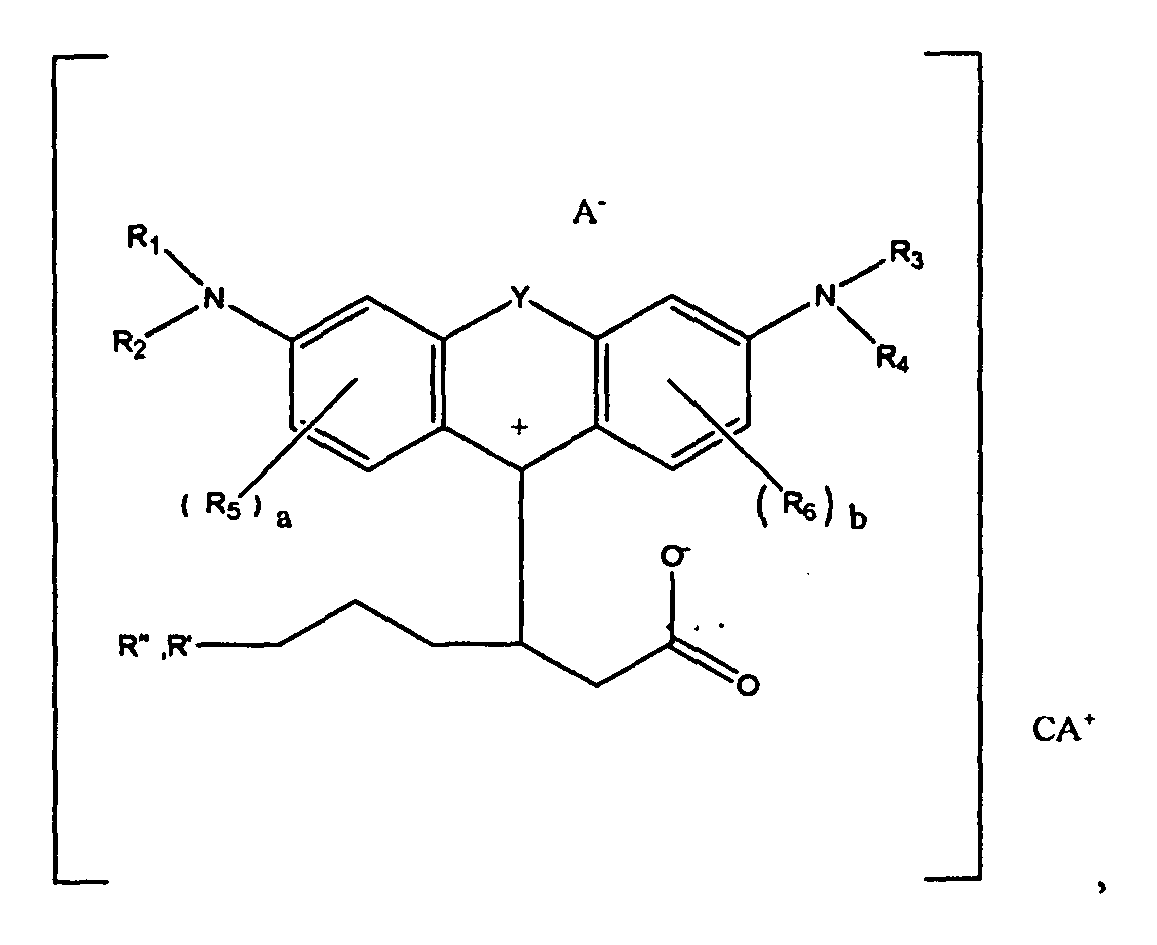




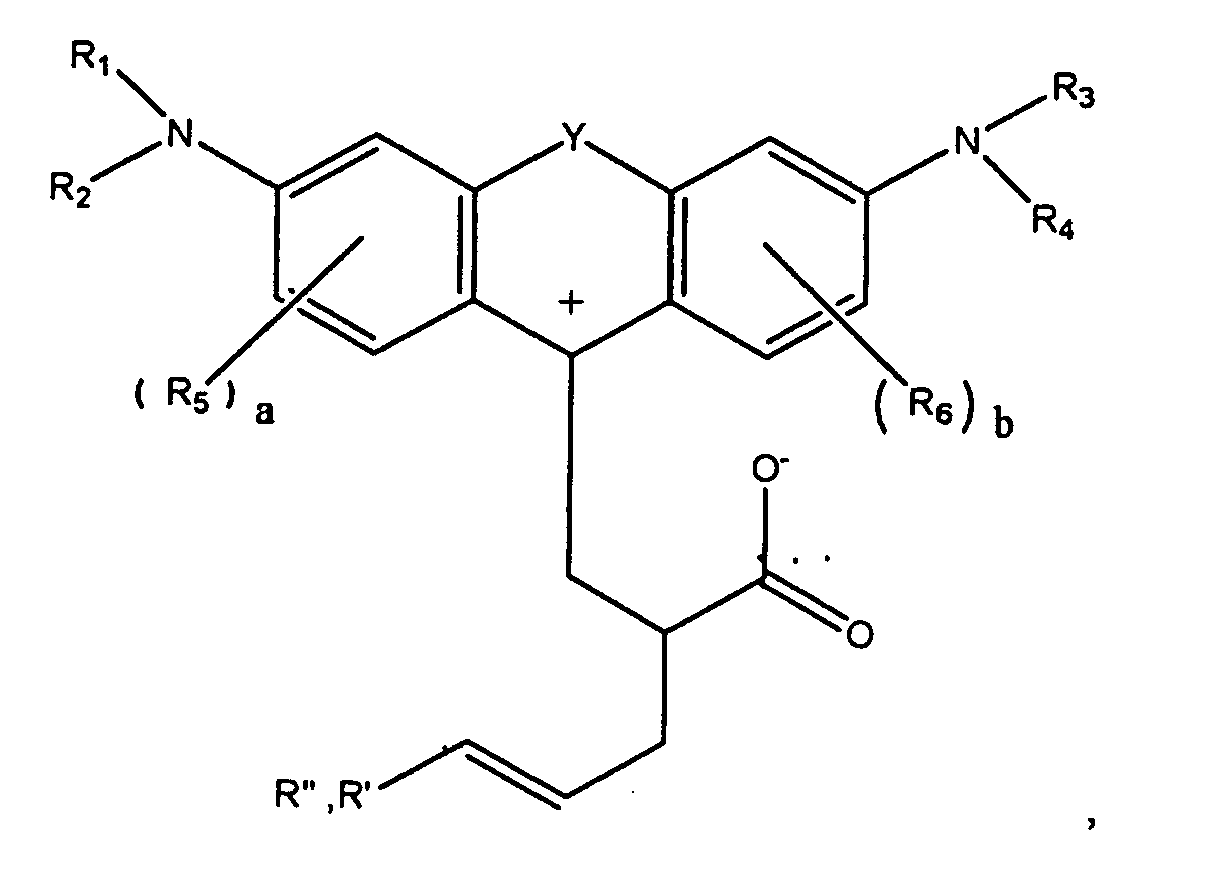



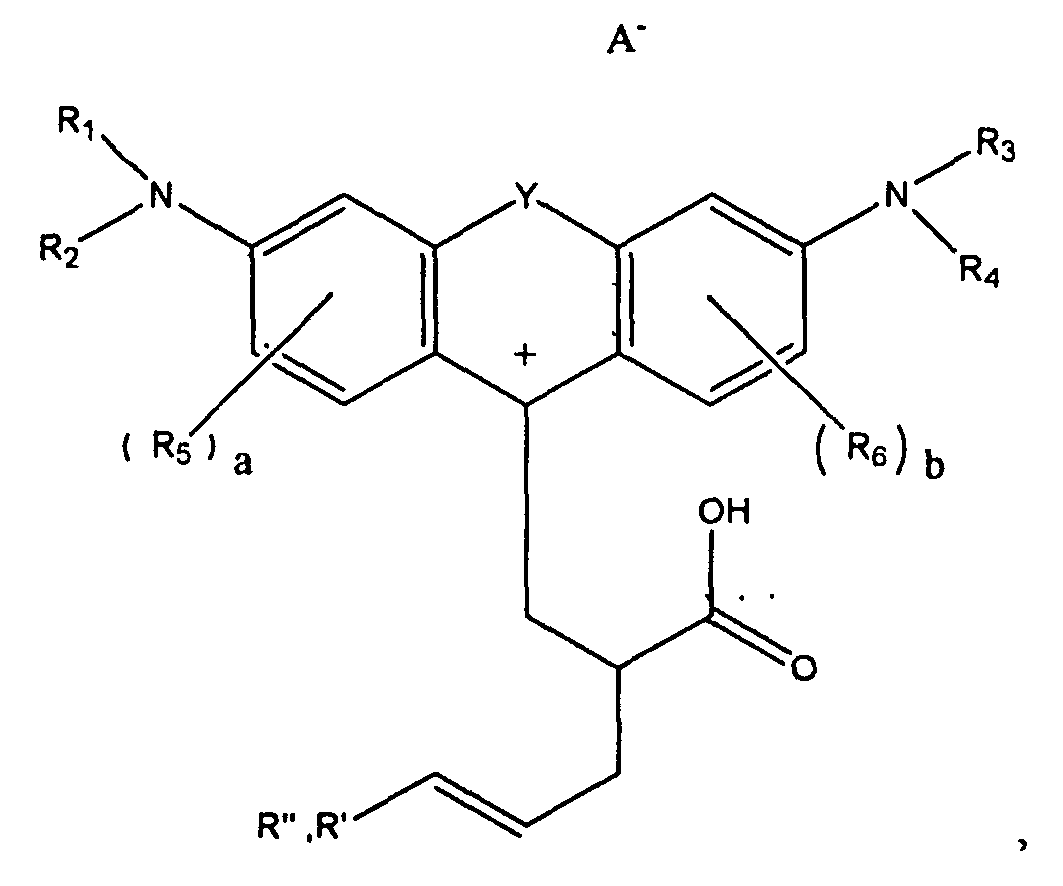
or

wherein R1, R2, R3, and R4 each, independently of the others, is (i) a hydrogen atom, (ii) an alkyl group, (iii) an aryl group, (iv) an arylalkyl group, or (v) an alkylaryl group, wherein R1 and R2 can be joined together to form a ring, wherein R3 and R4 can be joined together to form a ring, and wherein R1, R2, R3, and R4 can each be joined to a phenyl ring in the central structure; wherein a and b each, independently of the others, is an integer which is 0, 1, 2, or 3;
wherein R5 and R6 are each optionally present and wherein each of R5 and R6 independently of the other, if present, are independently selected from (i) an alkyl group, (ii) an aryl group, (iii) an arylalkyl group, (iv) an alkylaryl group, (v) a halogen atom, (vi) an ester group, (vii) an amide group, (viii) a sulfone group, (ix) an amine group or ammonium group, (x) a nitrile group, (xi) a nitro group, (xii) a hydroxy group, (xiii) a cyano group, (xiv) a pyridine or pyridinium group, (xv) an ether group, (xvi) an aldehyde group, (xvii) a ketone group, (xviii) a carbonyl group, (xix) a thiocarbonyl group, (xx) a sulfate group, (xxi) a sulfide group, (xxii) a sulfoxide group, (xxiii) a phosphine or phosphonium group, (xxiv) a phosphate group, (xxv) a mercapto group, (xxvi) a nitroso group, (xxvii) an acyl group, (xxviii) an acid anhydride group, (xxix) an azide group, (xxx) an azo group, (xxxi) a cyanato group, (xxxii) an isocyanato group, (xxxiii) a thiocyanato group, (xxxiv) an isothiocyanato group, (xxxv) a urethane group, or (xxxvi) a urea group, wherein R5 and R6 can each be joined to a phenyl ring in the central structure,
wherein
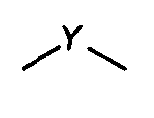
is

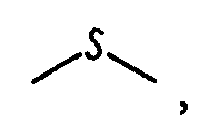
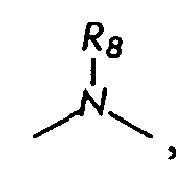
or

wherein R8, R9, and R10 each, independently of the other, is optionally present and wherein each of R8, R9, and R10, if present, is independently selected from (i) a hydrogen atom, (ii) an alkyl group, (iii) an aryl group, (iv) an arylalkyl group, or (v) an alkylaryl group;
wherein R" is optionally present and wherein R' and R", if present, are each independently selected from (i) an alkyl group, (ii) an aryl group, (iii) an arylalkyl group, or (iv) an alkylaryl group; and
wherein at least one of R' or R" contains at least about 5 carbon atoms.
or
wherein R1, R2, R3, and R4 each, independently of the others, is (i) a hydrogen atom, (ii) an alkyl group, (iii) an aryl group, (iv) an arylalkyl group, or (v) an alkylaryl group, wherein R1 and R2 can be joined together to form a ring, wherein R3 and R4 can be joined together to form a ring, and wherein R1, R2, R3, and R4 can each be joined to a phenyl ring in the central structure; wherein a and b each, independently of the others, is an integer which is 0, 1, 2, or 3;
wherein R5 and R6 are each optionally present and wherein each of R5 and R6 independently of the other, if present, are independently selected from (i) an alkyl group, (ii) an aryl group, (iii) an arylalkyl group, (iv) an alkylaryl group, (v) a halogen atom, (vi) an ester group, (vii) an amide group, (viii) a sulfone group, (ix) an amine group or ammonium group, (x) a nitrile group, (xi) a nitro group, (xii) a hydroxy group, (xiii) a cyano group, (xiv) a pyridine or pyridinium group, (xv) an ether group, (xvi) an aldehyde group, (xvii) a ketone group, (xviii) a carbonyl group, (xix) a thiocarbonyl group, (xx) a sulfate group, (xxi) a sulfide group, (xxii) a sulfoxide group, (xxiii) a phosphine or phosphonium group, (xxiv) a phosphate group, (xxv) a mercapto group, (xxvi) a nitroso group, (xxvii) an acyl group, (xxviii) an acid anhydride group, (xxix) an azide group, (xxx) an azo group, (xxxi) a cyanato group, (xxxii) an isocyanato group, (xxxiii) a thiocyanato group, (xxxiv) an isothiocyanato group, (xxxv) a urethane group, or (xxxvi) a urea group, wherein R5 and R6 can each be joined to a phenyl ring in the central structure,
wherein
is
or
wherein R8, R9, and R10 each, independently of the other, is optionally present and wherein each of R8, R9, and R10, if present, is independently selected from (i) a hydrogen atom, (ii) an alkyl group, (iii) an aryl group, (iv) an arylalkyl group, or (v) an alkylaryl group;
wherein R" is optionally present and wherein R' and R", if present, are each independently selected from (i) an alkyl group, (ii) an aryl group, (iii) an arylalkyl group, or (iv) an alkylaryl group; and
wherein at least one of R' or R" contains at least about 5 carbon atoms.
2. A compound according to claim 1 wherein a and b are each zero.
3. A compound according to claim 1 wherein
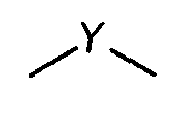
is

is
4. A compound according to claim 1 wherein A- is an organic dianion of the formula A1-R11-A2
wherein A1 and A2 each, independently of the other, are anions and wherein R11 is
(i) an alkylene group, (ii) an arylene group, (iii) an arylalkylene group, or (iv)
an alkylarylene group.
5. A compound according to claim 1 wherein at least one of R1, R2, R3, and R4 is an alkyl group.
6. A compound according to claim 8 wherein the alkyl group is a linear alkyl group or
a branched alkyl group.
7. A compound according to claim 1, of the formula







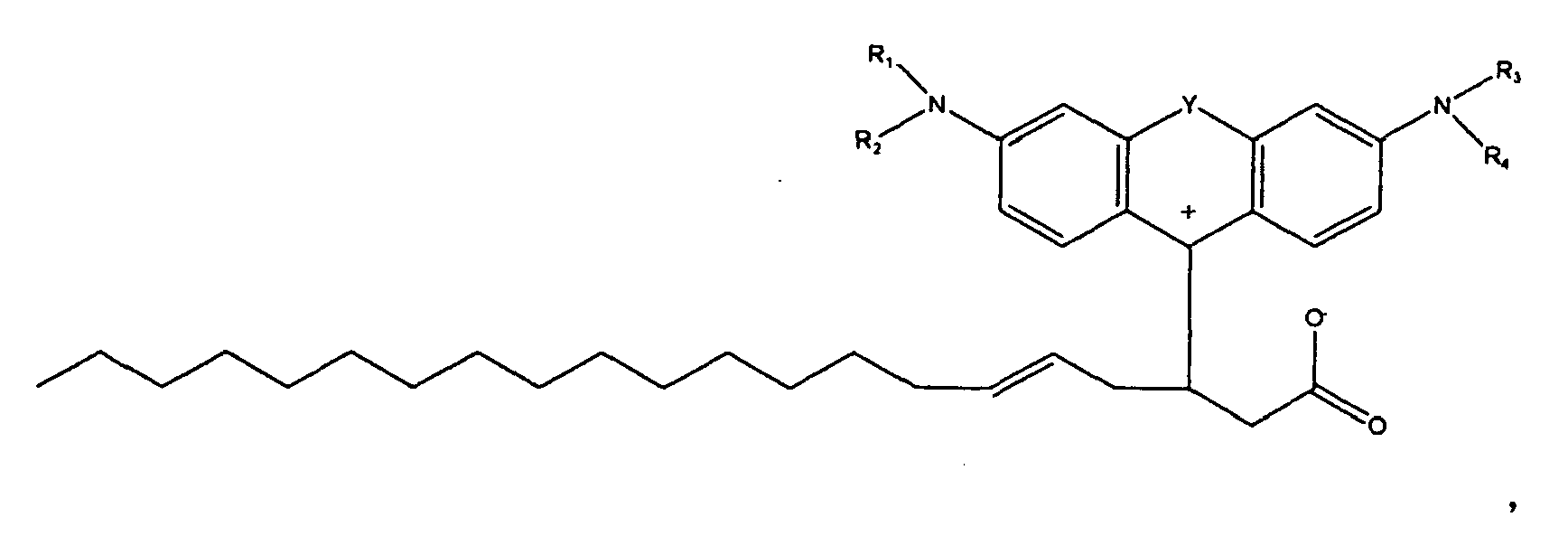


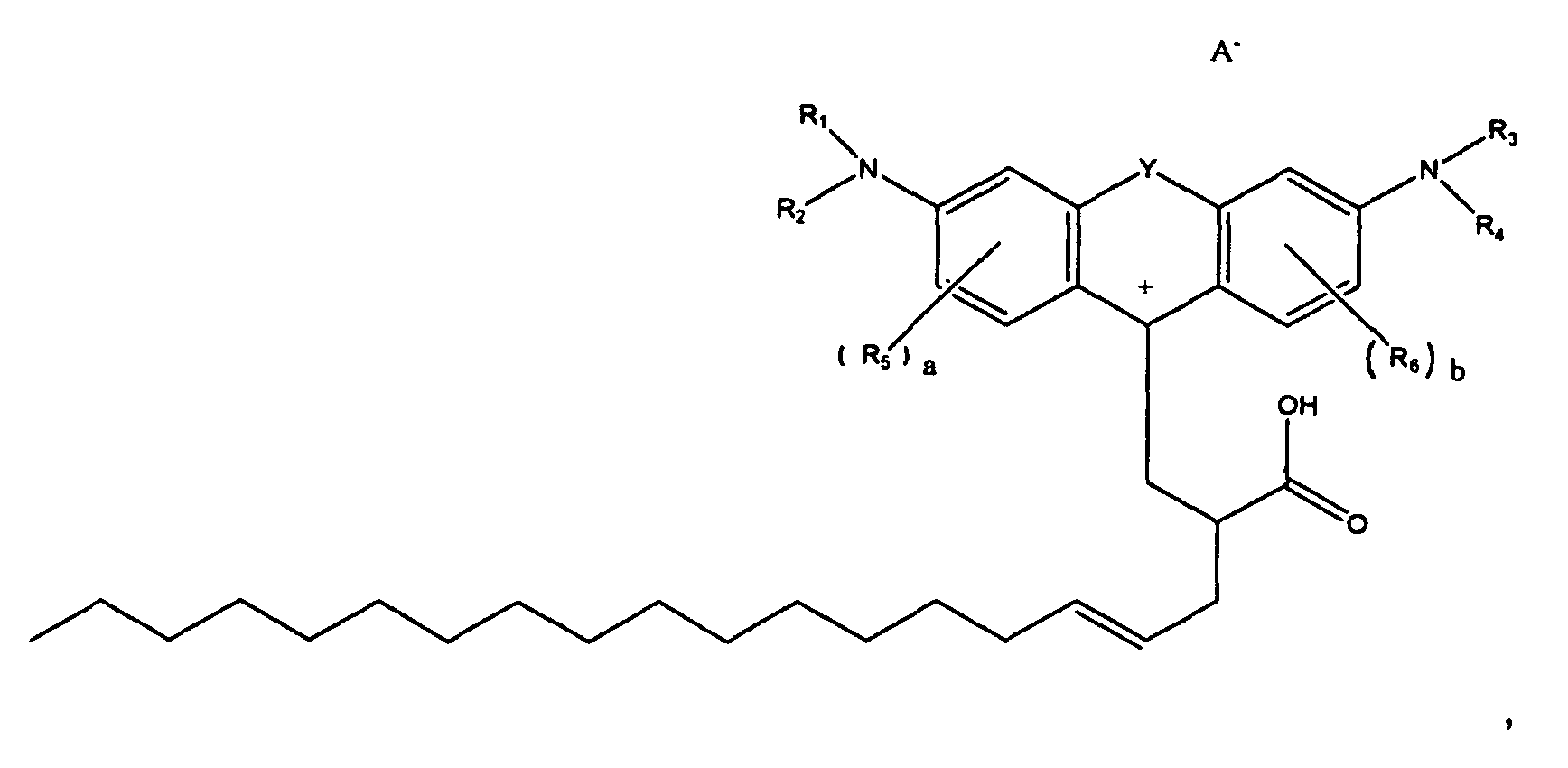
or

or
8. A compound of the formula

9. A compound of the formula

10. A compound of the formula
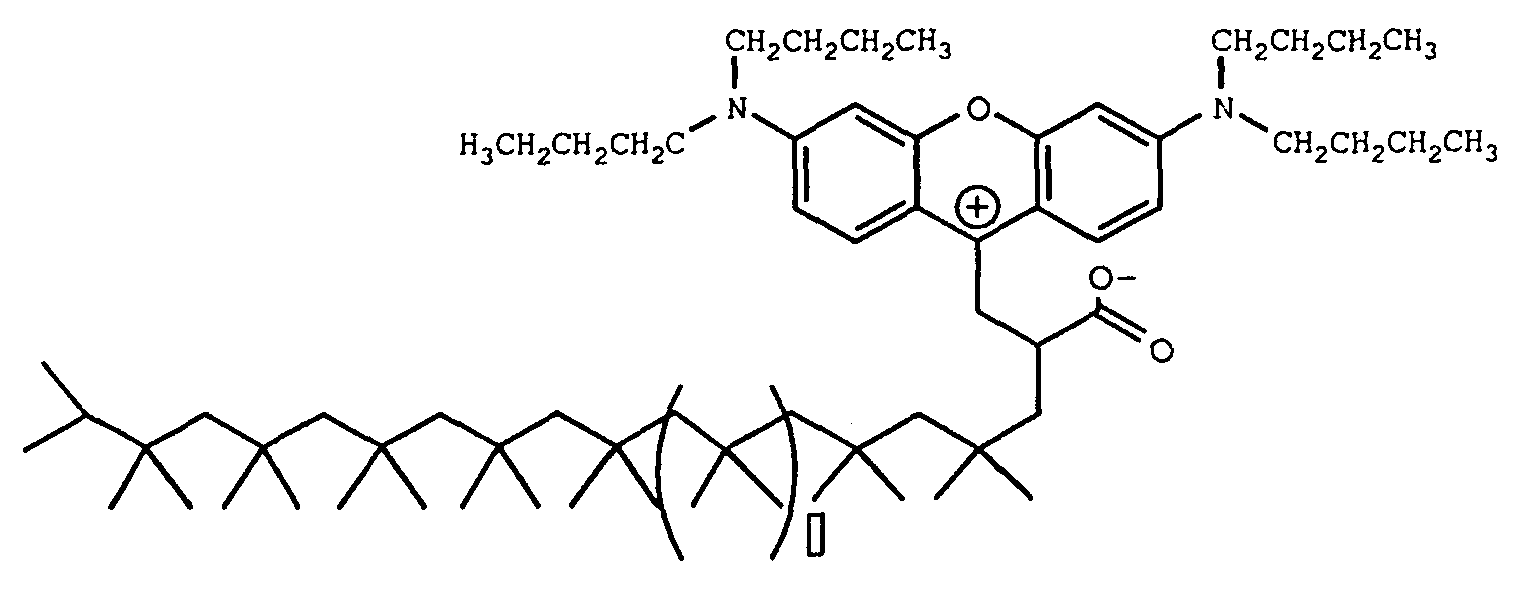
wherein □ is 7.
wherein □ is 7.
1. Verbindung der Formel
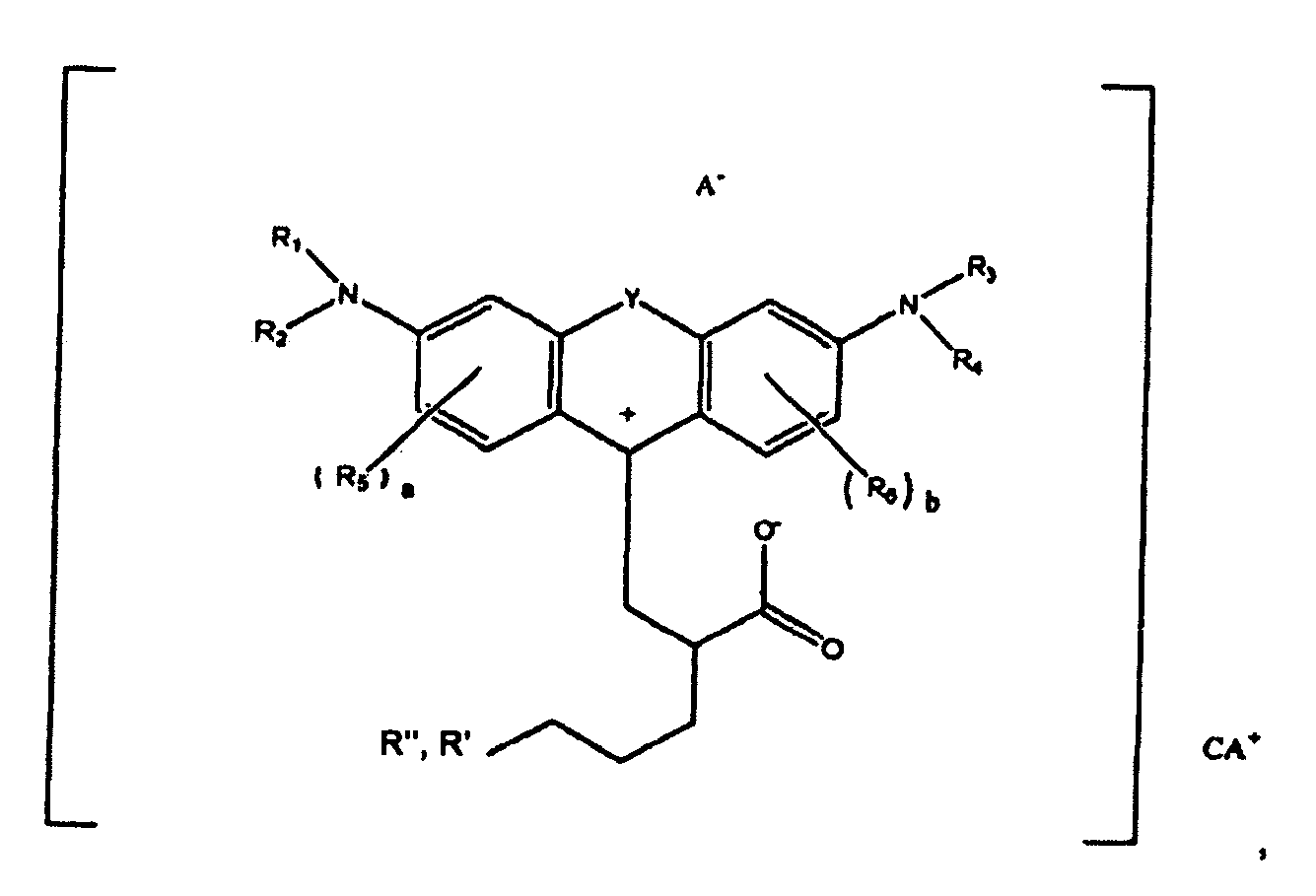



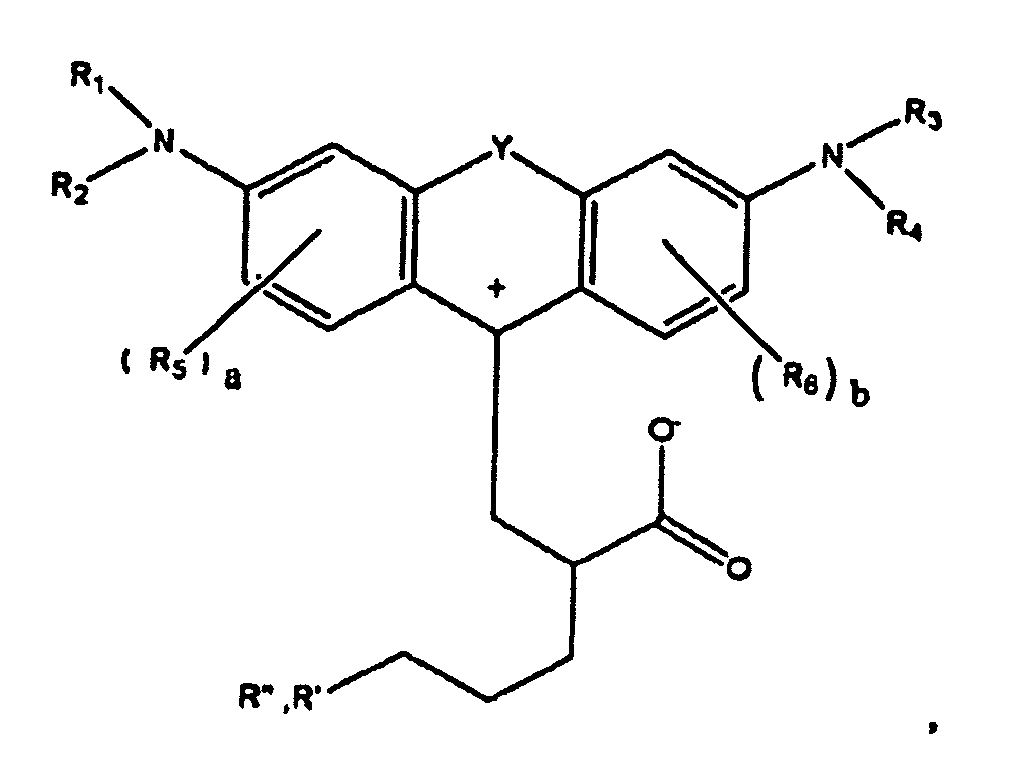

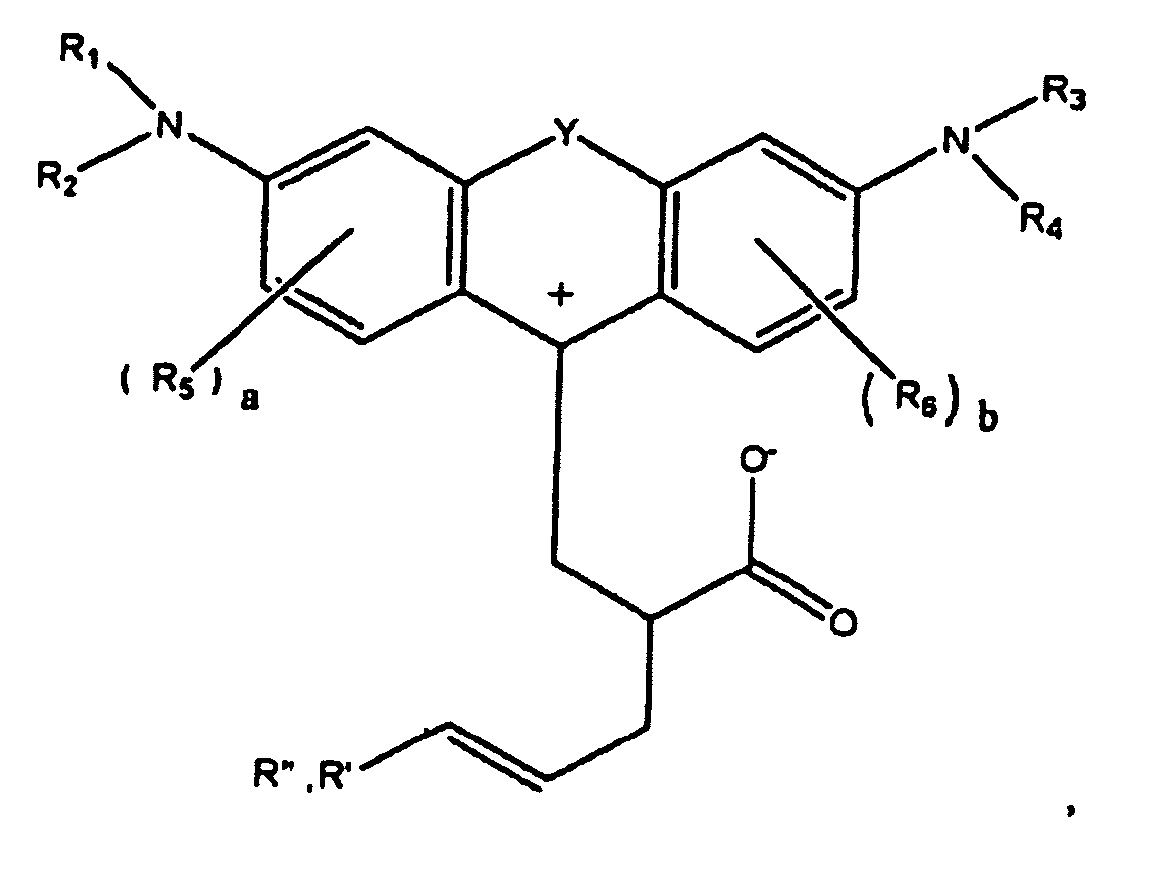
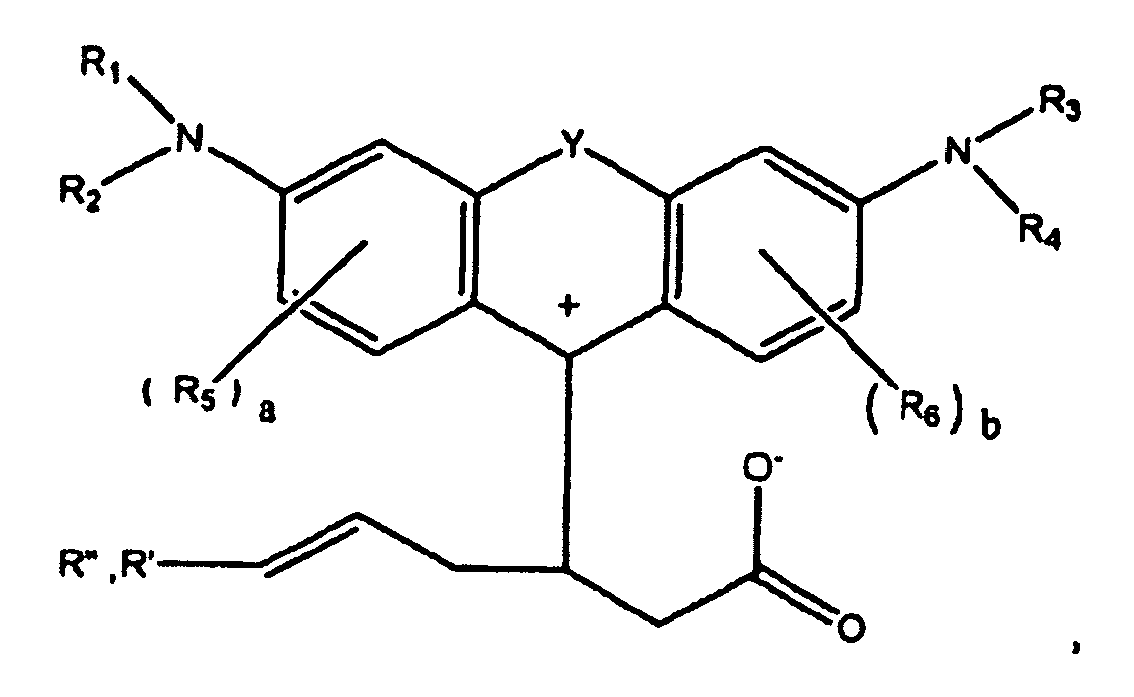



oder

wobei R1, R2, R3 und R4 jeweils unabhängig von den anderen (i) ein Wasserstoffatom, (ii) eine Alkylgruppe, (iii) eine Arylgruppe, (iv) eine Arylalkylgruppe oder (v) eine Alkylarylgruppe ist, wobei R1 und R2 miteinander verbunden sein können unter Bildung eines Rings, wobei R3 und R4 miteinander verbunden sein können unter Bildung eines Rings, und wobei R1, R2, R3 und R4 jeweils an einen Phenylring in der zentralen Struktur gebunden sein können; wobei a und b jeweils unabhängig von den anderen eine ganze Zahl ist, welche 0, 1, 2 oder 3 beträgt;
wobei R5 und R6 jeweils optional vorhanden sind und wobei jedes von R5 und R6 unabhängig von dem anderen, falls es vorhanden ist, unabhängig ausgewählt ist aus (i) einer Alkylgruppe, (ii) einer Arylgruppe, (iii) einer Arylalkylgruppe, (iv) einer Alkylarylgruppe, (v) einem Halogenatom, (vi) einer Estergruppe, (vii) einer Amidgruppe, (viii) einer Sulfongruppe, (ix) einer Amingruppe oder Ammoniumgruppe, (x) einer Nitrilgruppe, (xi) einer Nitrogruppe, (xii) einer Hydroxygruppe, (xiii) einer Cyanogruppe, (xiv) einer Pyridin- oder Pyridiniumgruppe, (xv) einer Ethergruppe, (xvi) einer Aldehydgruppe, (xvii) einer Ketongruppe, (xviii) einer Carbonylgruppe, (xix) einer Thiocarbonylgruppe, (xx) einer Sulfatgruppe, (xxi) einer Sulfidgruppe, (xxii) einer Sulfoxidgruppe, (xxiii) einer Phosphin- oder Phosphoniumgruppe, (xxiv) einer Phosphatgruppe, (xxv) einer Mercaptogruppe, (xxvi) einer Nitrosogruppe, (xxvii) einer Acylgruppe, (xxviii) einer Säureanhydridgruppe, (xxix) einer Azidgruppe, (xxx) einer Azogruppe, (xxxi) einer Cyanatogruppe, (xxxii) einer Isocyanatogruppe, (xxxiii) einer Thiocyanatogruppe, (xxxiv) einer Isothiocyanatogruppe, (xxxv) einer Urethangruppe oder (xxxvi) einer Harnstoffgruppe, wobei R5 und R6 jeweils an einen Phenylring in der zentralen Struktur gebunden sein können
wobei

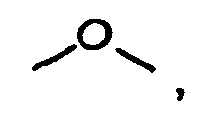


oder
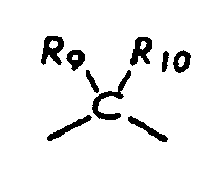
ist;
wobei R8, R9 und R10 jeweils unabhängig von dem anderen optional vorhanden ist und wobei jedes von R8, R9 und R10, falls es vorhanden ist, unabhängig ausgewählt ist aus (i) einem Wasserstoffatom, (ii) einer Alkylgruppe, (iii) einer Arylgruppe, (iv) einer Arylalkylgruppe oder (v) einer Alkylarylgruppe;
wobei R" optional vorhanden ist und wobei R' und R", falls es vorhanden ist, jeweils unabhängig voneinander ausgewählt sind aus (i) einer Alkylgruppe, (ii) einer Arylgruppe, (iii) einer Arylalkylgruppe oder (iv) einer Alkylarylgruppe; und
wobei wenigstens eines von R' oder R" wenigstens ungefähr 5 Kohlenstoffatome enthält.
oder
wobei R1, R2, R3 und R4 jeweils unabhängig von den anderen (i) ein Wasserstoffatom, (ii) eine Alkylgruppe, (iii) eine Arylgruppe, (iv) eine Arylalkylgruppe oder (v) eine Alkylarylgruppe ist, wobei R1 und R2 miteinander verbunden sein können unter Bildung eines Rings, wobei R3 und R4 miteinander verbunden sein können unter Bildung eines Rings, und wobei R1, R2, R3 und R4 jeweils an einen Phenylring in der zentralen Struktur gebunden sein können; wobei a und b jeweils unabhängig von den anderen eine ganze Zahl ist, welche 0, 1, 2 oder 3 beträgt;
wobei R5 und R6 jeweils optional vorhanden sind und wobei jedes von R5 und R6 unabhängig von dem anderen, falls es vorhanden ist, unabhängig ausgewählt ist aus (i) einer Alkylgruppe, (ii) einer Arylgruppe, (iii) einer Arylalkylgruppe, (iv) einer Alkylarylgruppe, (v) einem Halogenatom, (vi) einer Estergruppe, (vii) einer Amidgruppe, (viii) einer Sulfongruppe, (ix) einer Amingruppe oder Ammoniumgruppe, (x) einer Nitrilgruppe, (xi) einer Nitrogruppe, (xii) einer Hydroxygruppe, (xiii) einer Cyanogruppe, (xiv) einer Pyridin- oder Pyridiniumgruppe, (xv) einer Ethergruppe, (xvi) einer Aldehydgruppe, (xvii) einer Ketongruppe, (xviii) einer Carbonylgruppe, (xix) einer Thiocarbonylgruppe, (xx) einer Sulfatgruppe, (xxi) einer Sulfidgruppe, (xxii) einer Sulfoxidgruppe, (xxiii) einer Phosphin- oder Phosphoniumgruppe, (xxiv) einer Phosphatgruppe, (xxv) einer Mercaptogruppe, (xxvi) einer Nitrosogruppe, (xxvii) einer Acylgruppe, (xxviii) einer Säureanhydridgruppe, (xxix) einer Azidgruppe, (xxx) einer Azogruppe, (xxxi) einer Cyanatogruppe, (xxxii) einer Isocyanatogruppe, (xxxiii) einer Thiocyanatogruppe, (xxxiv) einer Isothiocyanatogruppe, (xxxv) einer Urethangruppe oder (xxxvi) einer Harnstoffgruppe, wobei R5 und R6 jeweils an einen Phenylring in der zentralen Struktur gebunden sein können
wobei
oder
ist;
wobei R8, R9 und R10 jeweils unabhängig von dem anderen optional vorhanden ist und wobei jedes von R8, R9 und R10, falls es vorhanden ist, unabhängig ausgewählt ist aus (i) einem Wasserstoffatom, (ii) einer Alkylgruppe, (iii) einer Arylgruppe, (iv) einer Arylalkylgruppe oder (v) einer Alkylarylgruppe;
wobei R" optional vorhanden ist und wobei R' und R", falls es vorhanden ist, jeweils unabhängig voneinander ausgewählt sind aus (i) einer Alkylgruppe, (ii) einer Arylgruppe, (iii) einer Arylalkylgruppe oder (iv) einer Alkylarylgruppe; und
wobei wenigstens eines von R' oder R" wenigstens ungefähr 5 Kohlenstoffatome enthält.
2. Verbindung nach Anspruch 1, wobei a und b jeweils Null sind.
3. Verbindung nach Anspruch 1, wobei
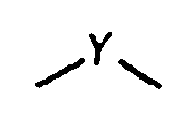

ist.
ist.
4. Verbindung nach Anspruch 1, wobei A- ein organisches Dianion der Formel A1-R11-A2 ist, wobei A1 und A2 jeweils unabhängig
von dem anderen Anionen sind und wobei R11 (i) eine Alkylengruppe, (ii) eine Arylengruppe,
(iii) eine Arylalkylengruppe oder (iv) eine Alkylarylengruppe ist.
5. Verbindung nach Anspruch 1, wobei wenigstens eines von R1, R2, R3 und R4 eine Alkylgruppe ist.
6. Verbindung nach Anspruch 5, wobei die Alkylgruppe eine lineare Alkylgruppe oder eine
verzweigte Alkylgruppe ist.
7. Verbindung nach Anspruch 1, der Formel
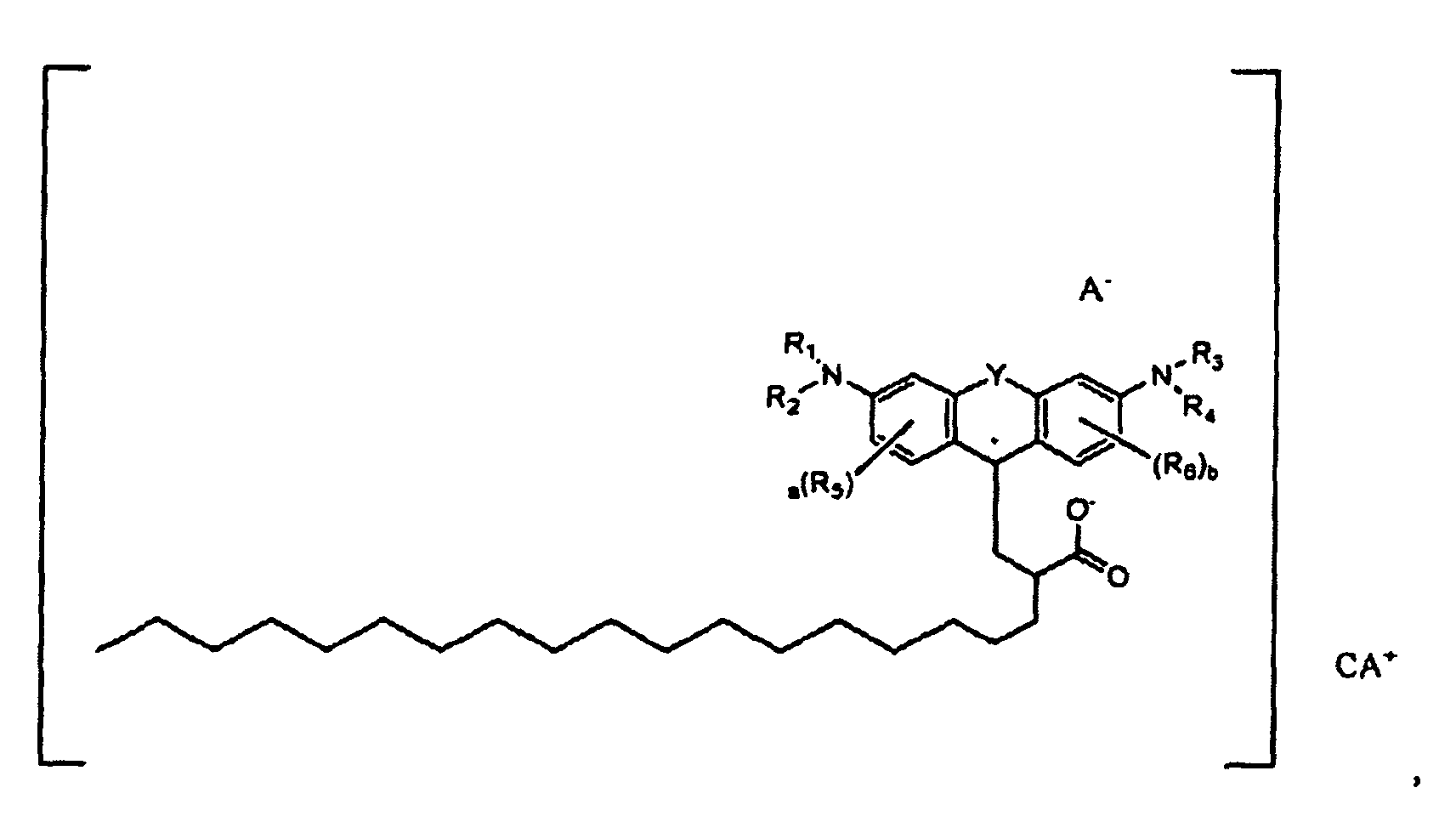






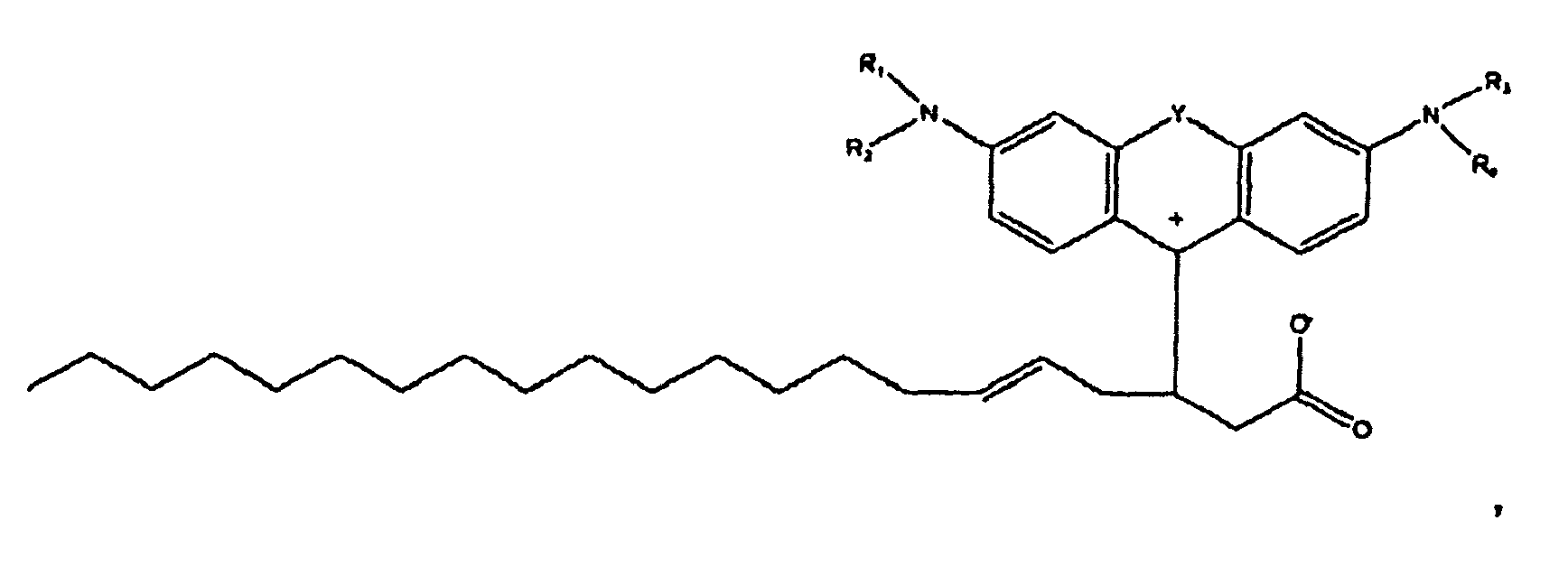



oder

oder
8. Verbindung der Formel
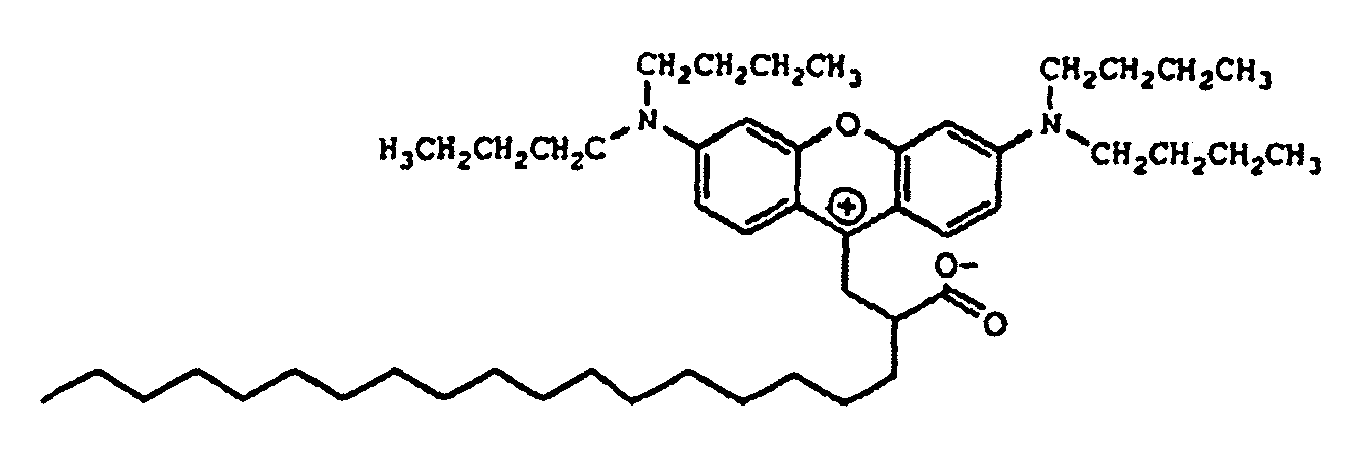
9. Verbindung der Formel

10. Verbindung der Formel
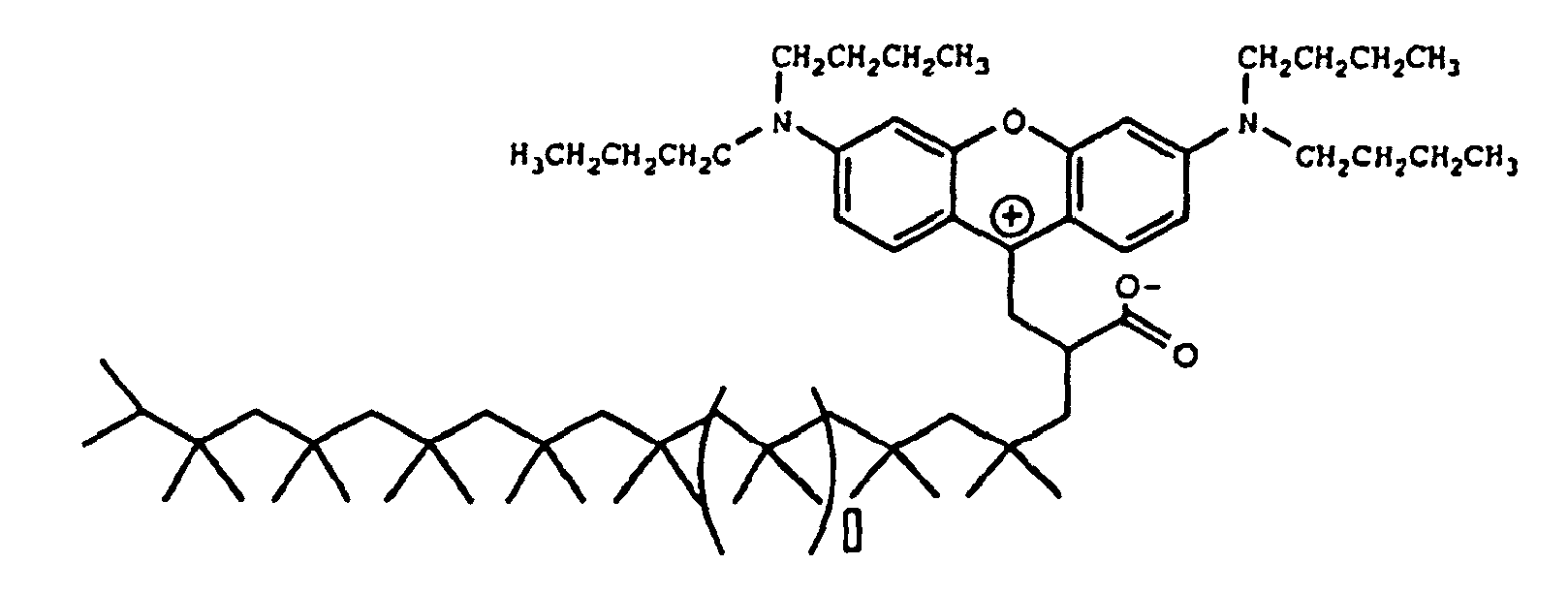
wobei □ 7 ist.
wobei □ 7 ist.
1. Composé de la formule
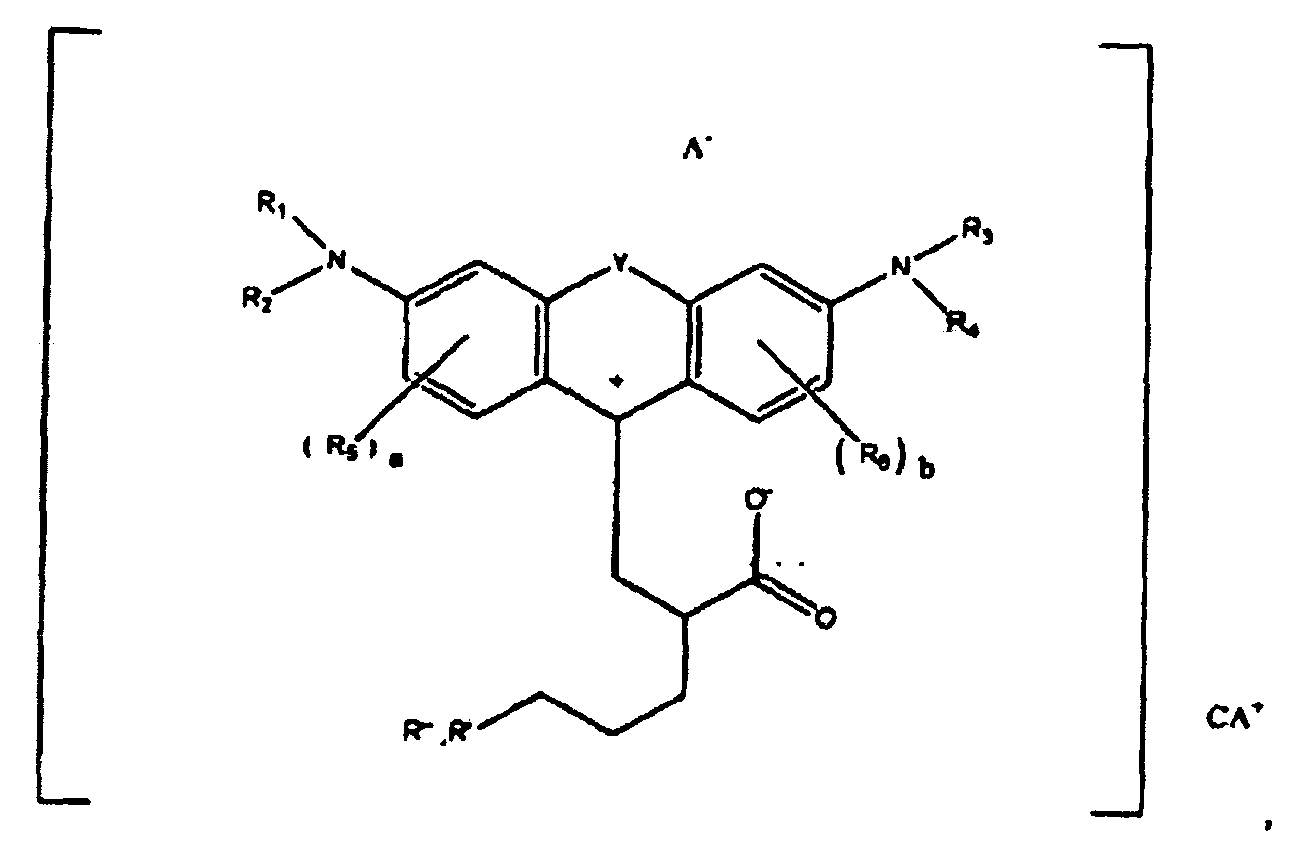
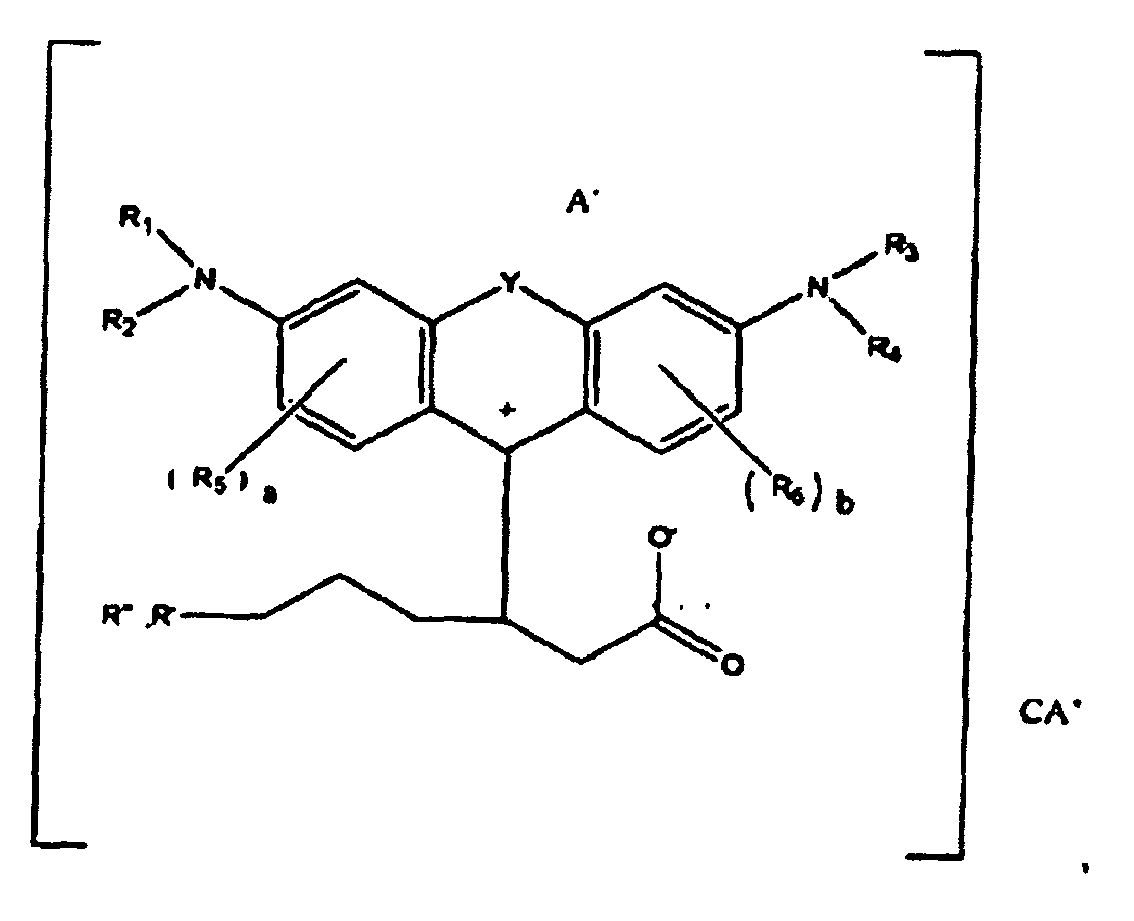


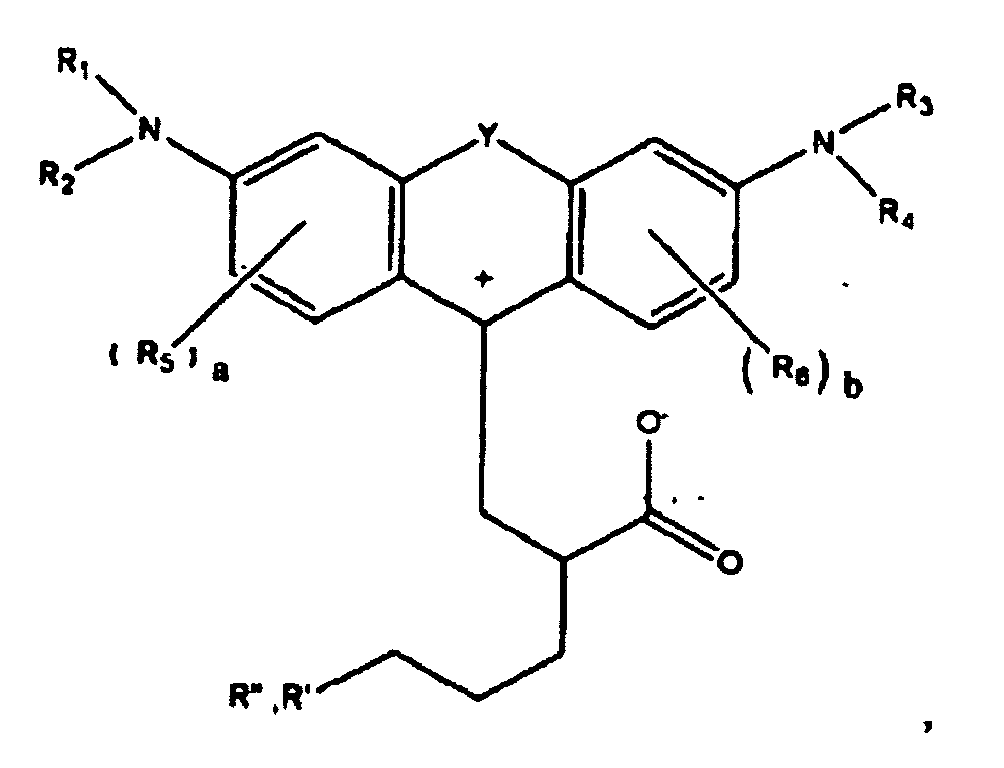
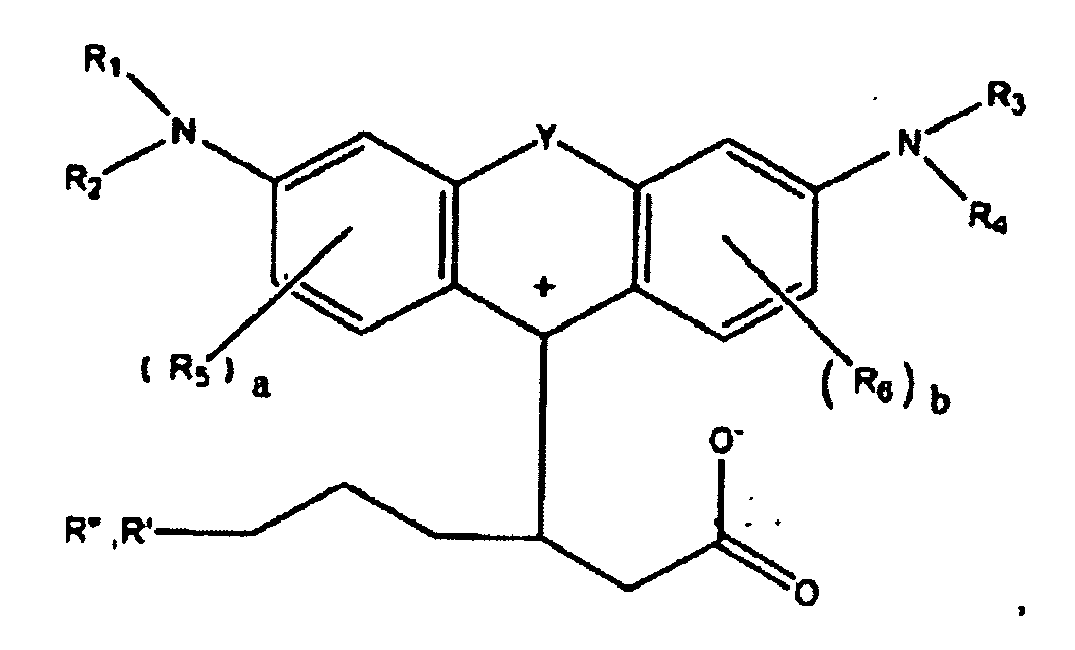
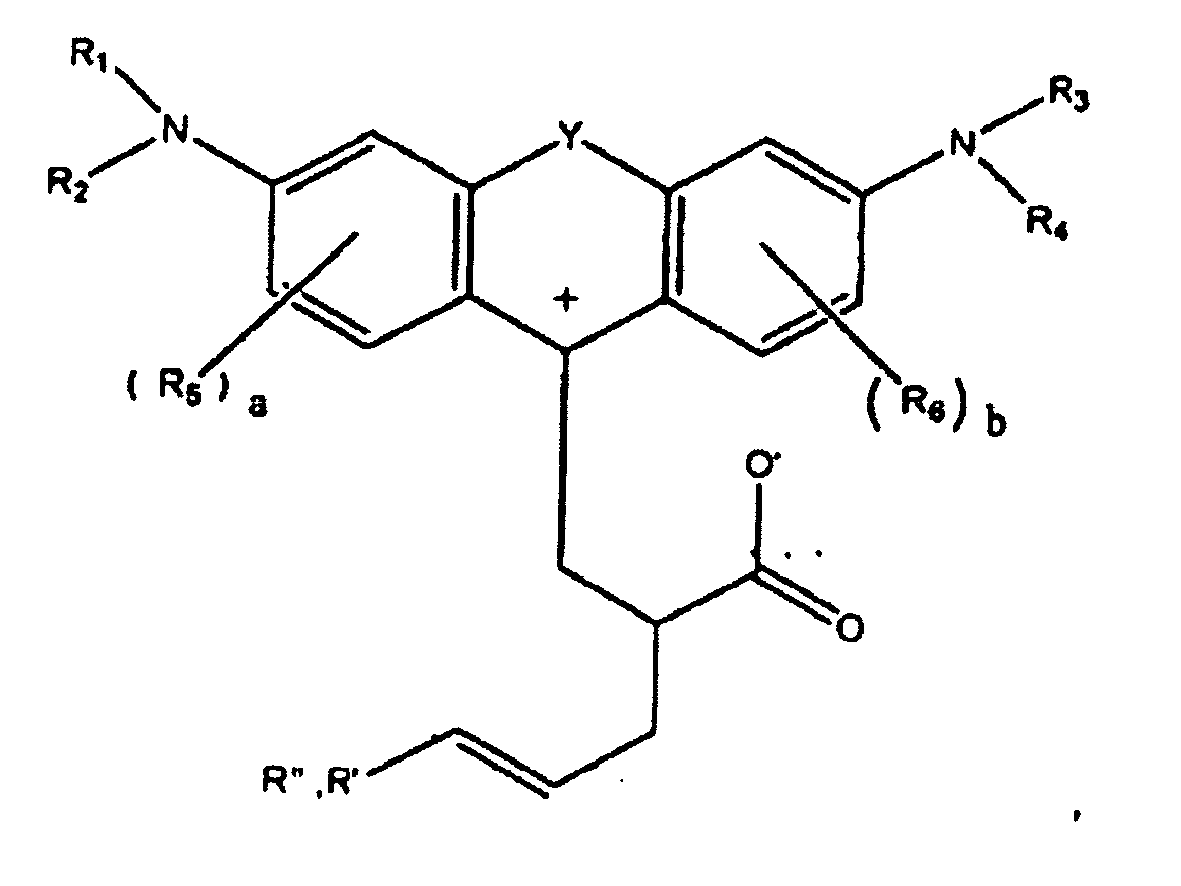




ou

dans lesquelles R1, R2, R3, et R4, chacun indépendamment des autres, est (i) un atome d'hydrogène, (ii) un groupe alkyle, (iii) un groupe aryle, (iv) un groupe arylalkyle, ou (v) un groupe alkylaryle, dans lesquelles R1 et R2 peuvent être joints ensemble pour former un cycle, dans lesquelles R3 et R4 peuvent être joints ensemble pour former un cycle, et dans lesquelles R1, R2, R3, et R4 peuvent chacun être joints à un cycle phényle dans la structure centrale ; dans lesquelles a et b, chacun indépendamment de l'autre, est un entier qui est 0, 1, 2, ou 3 ;
dans lesquelles R5 et R6 sont chacun facultativement présents et dans lesquelles chacun de R5 et R6 indépendamment de l'autre, s'ils sont présents, est indépendamment choisi parmi (i) un groupe alkyle, (ii) un groupe aryle, (iii) un groupe arylalkyle, (iv) un groupe alkylaryle, (v) un atome d'halogène, (vi) un groupe ester, (vii) un groupe amide, (viii) un groupe sulfone, (ix) un groupe amine ou un groupe ammonium, (x) un groupe nitrile, (xi) un groupe nitro, (xii) un groupe hydroxy, (xiii) un groupe cyano, (xiv) un groupe pyridine ou pyridinium, (xv) un groupe éther, (xvi) un groupe aldéhyde, (xvii) un groupe cétone, (xviii) un groupe carbonyle, (xix) un groupe thiocarbonyle, (xx) un groupe sulfate, (xxi) un groupe sulfure, (xxii) un groupe sulfoxyde, (xxiii) un groupe phosphine ou phosphonium, (xxiv) un groupe phosphate, (xxv) un groupe mercapto, (xxvi) un groupe nitroso, (xxvii) un groupe acyle, (xxviii) un groupe anhydride acide, (xxix) un groupe azide, (xxx) un groupe azo, (xxxi) un groupe cyanato, (xxxii) un groupe isocyanato, (xxxiii) un groupe thiocyanato, (xxxiv) un groupe isothiocyanato, (xxxv) un groupe uréthane, ou (xxxvi) un groupe urée, dans lesquelles R5 et R6 peuvent chacun être joints à un cycle phényle dans la structure centrale
dans lesquelles

est
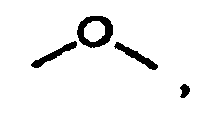
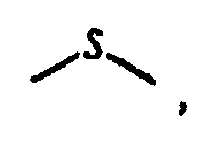

ou
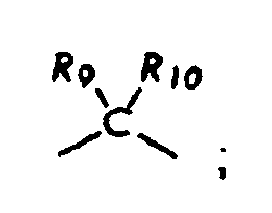
dans lesquelles R8, R9, et R10, chacun indépendamment de l'autre, est facultativement présent et dans lesquelles chacun de R8, R9, et R10, s'il est présent, est indépendamment choisi parmi (i) un atome d'hydrogène, (ii) un groupe alkyle, (iii) un groupe aryle, (iv) un groupe arylalkyle, ou (v) un groupe alkylaryle ;
dans lesquelles R" est facultativement présent et dans lesquelles R' et R", s'il est présent, sont chacun indépendamment choisis parmi (i) un groupe alkyle, (ii) un groupe aryle, (iii) un groupe arylalkyle, ou (iv) un groupe alkylaryle ; et
dans lesquelles au moins l'un de R' ou R" contient au moins 5 atomes de carbone.
ou
dans lesquelles R1, R2, R3, et R4, chacun indépendamment des autres, est (i) un atome d'hydrogène, (ii) un groupe alkyle, (iii) un groupe aryle, (iv) un groupe arylalkyle, ou (v) un groupe alkylaryle, dans lesquelles R1 et R2 peuvent être joints ensemble pour former un cycle, dans lesquelles R3 et R4 peuvent être joints ensemble pour former un cycle, et dans lesquelles R1, R2, R3, et R4 peuvent chacun être joints à un cycle phényle dans la structure centrale ; dans lesquelles a et b, chacun indépendamment de l'autre, est un entier qui est 0, 1, 2, ou 3 ;
dans lesquelles R5 et R6 sont chacun facultativement présents et dans lesquelles chacun de R5 et R6 indépendamment de l'autre, s'ils sont présents, est indépendamment choisi parmi (i) un groupe alkyle, (ii) un groupe aryle, (iii) un groupe arylalkyle, (iv) un groupe alkylaryle, (v) un atome d'halogène, (vi) un groupe ester, (vii) un groupe amide, (viii) un groupe sulfone, (ix) un groupe amine ou un groupe ammonium, (x) un groupe nitrile, (xi) un groupe nitro, (xii) un groupe hydroxy, (xiii) un groupe cyano, (xiv) un groupe pyridine ou pyridinium, (xv) un groupe éther, (xvi) un groupe aldéhyde, (xvii) un groupe cétone, (xviii) un groupe carbonyle, (xix) un groupe thiocarbonyle, (xx) un groupe sulfate, (xxi) un groupe sulfure, (xxii) un groupe sulfoxyde, (xxiii) un groupe phosphine ou phosphonium, (xxiv) un groupe phosphate, (xxv) un groupe mercapto, (xxvi) un groupe nitroso, (xxvii) un groupe acyle, (xxviii) un groupe anhydride acide, (xxix) un groupe azide, (xxx) un groupe azo, (xxxi) un groupe cyanato, (xxxii) un groupe isocyanato, (xxxiii) un groupe thiocyanato, (xxxiv) un groupe isothiocyanato, (xxxv) un groupe uréthane, ou (xxxvi) un groupe urée, dans lesquelles R5 et R6 peuvent chacun être joints à un cycle phényle dans la structure centrale
dans lesquelles
est
ou
dans lesquelles R8, R9, et R10, chacun indépendamment de l'autre, est facultativement présent et dans lesquelles chacun de R8, R9, et R10, s'il est présent, est indépendamment choisi parmi (i) un atome d'hydrogène, (ii) un groupe alkyle, (iii) un groupe aryle, (iv) un groupe arylalkyle, ou (v) un groupe alkylaryle ;
dans lesquelles R" est facultativement présent et dans lesquelles R' et R", s'il est présent, sont chacun indépendamment choisis parmi (i) un groupe alkyle, (ii) un groupe aryle, (iii) un groupe arylalkyle, ou (iv) un groupe alkylaryle ; et
dans lesquelles au moins l'un de R' ou R" contient au moins 5 atomes de carbone.
2. Composé selon la revendication 1 dans lequel a et b sont chacun zéro.
3. Composé selon la revendication 1 dans lequel
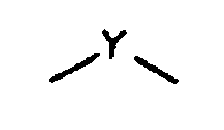
est
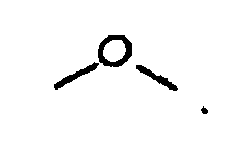
est
4. Composé selon la revendication 1 dans lequel A-est un dianion organique de la formule
A1-R11-A2 dans laquelle A1 et A2, chacun indépendamment de l'autre, sont des anions
et dans laquelle R11 est (i) un groupe alkylène, (ii) un groupe arylène, (iii) un
groupe arylalkylène, ou (iv) un groupe alkylarylène.
5. Composé selon la revendication 1 dans lequel au moins l'un de R1, R2, R3, et R4 est un groupe alkyle.
6. Composé selon la revendication 5 dans lequel le groupe alkyle est un groupe alkyle
linéaire ou un groupe alkyle ramifié.
7. Composé selon la revendication 1, de la formule


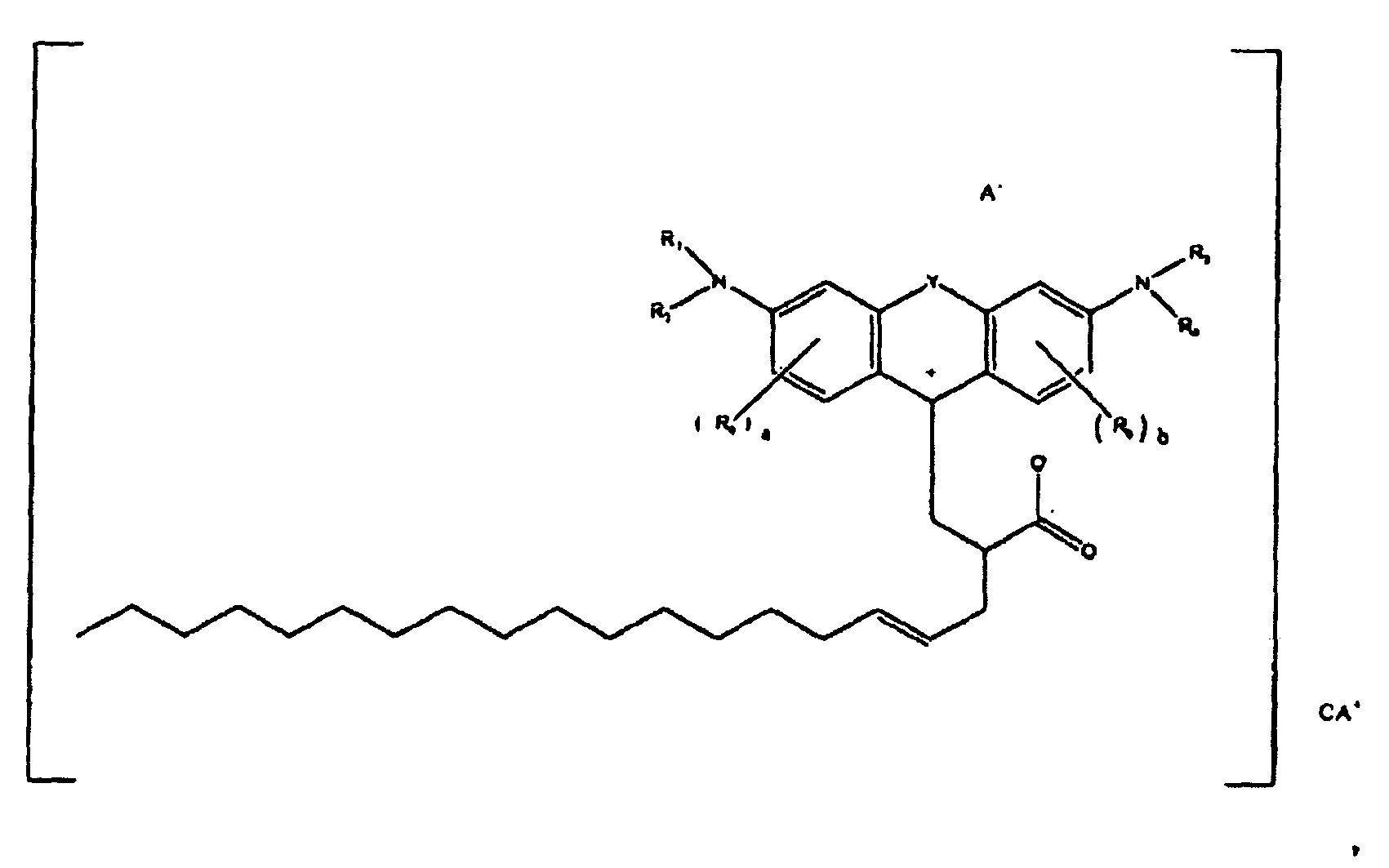

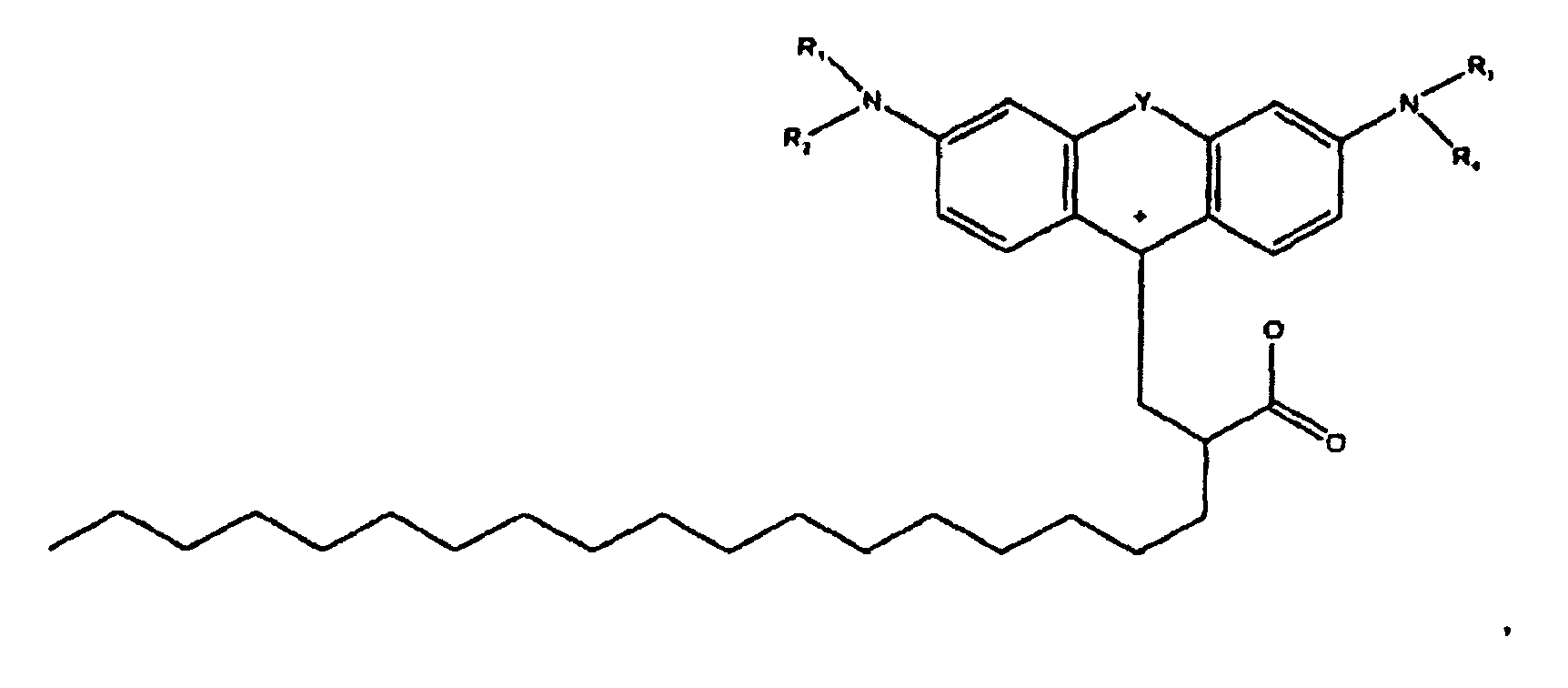

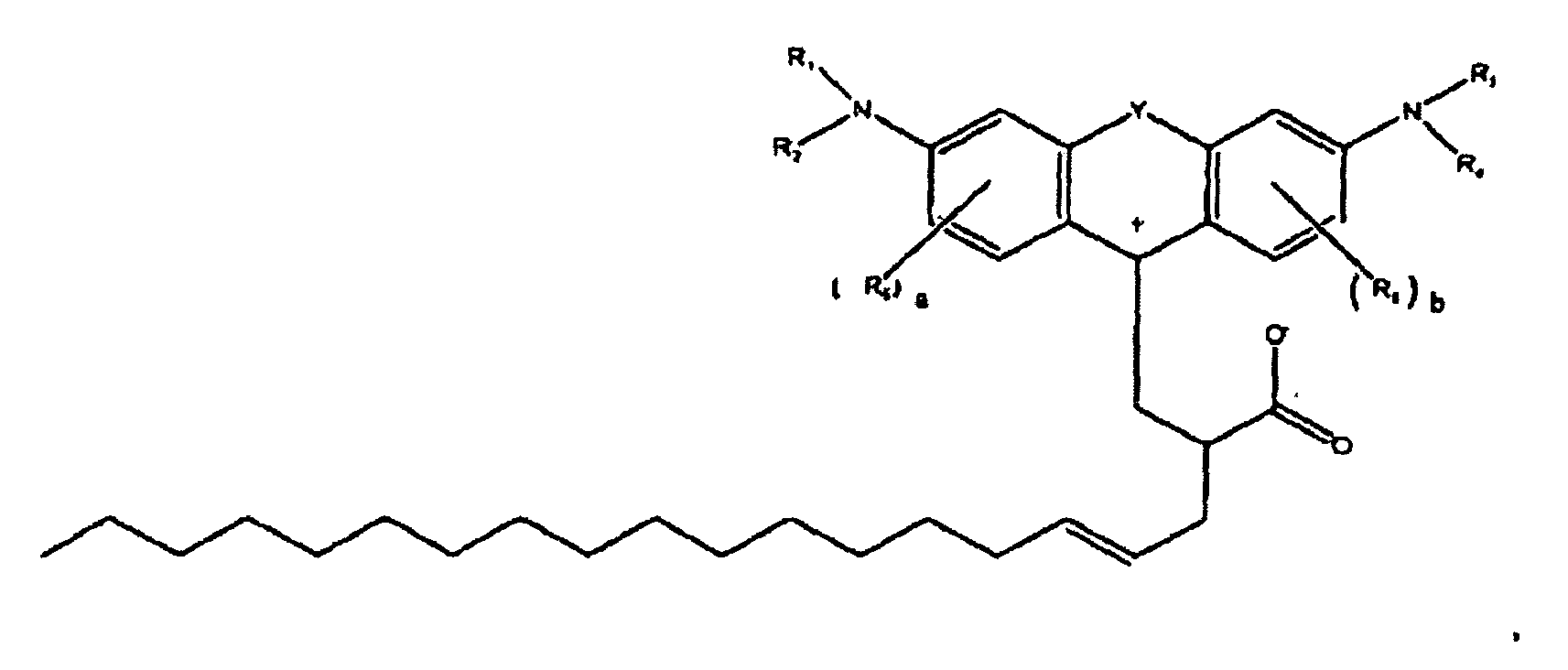




ou

ou
8. Composé de la formule

9. Composé de la formule

10. Composé de la formule
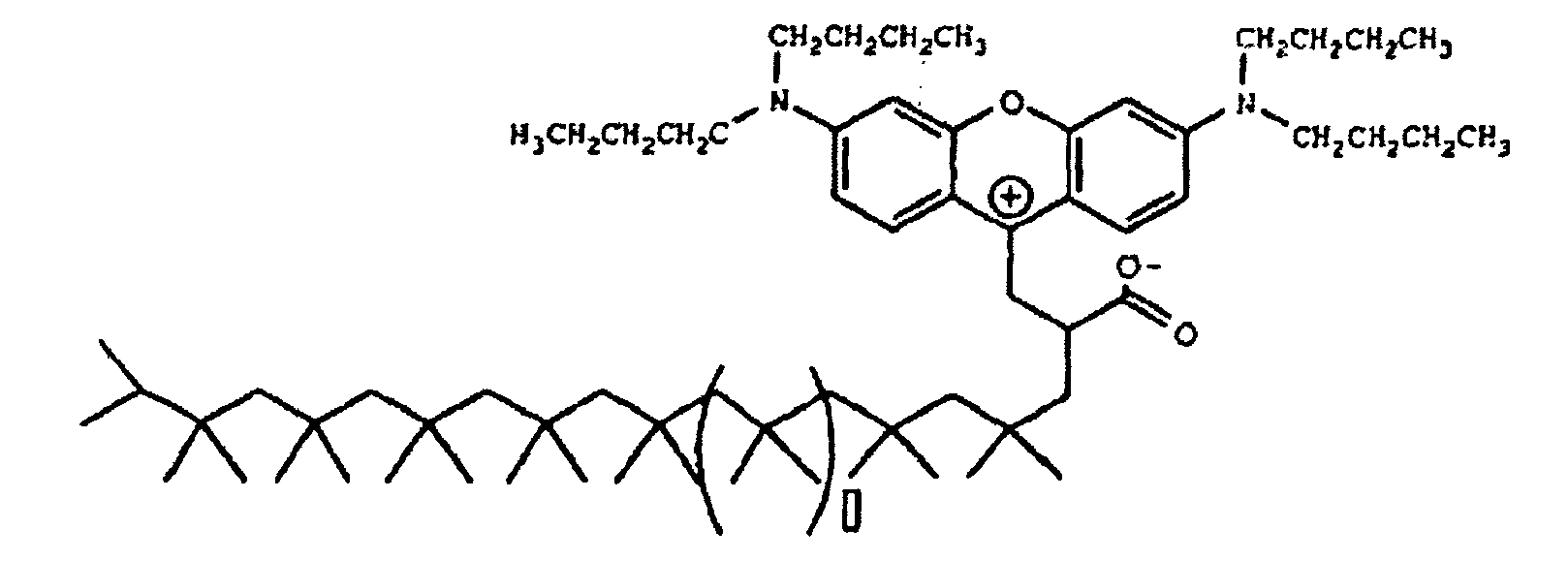
dans laquelle 0 est 7.
dans laquelle 0 est 7.
REFERENCES CITED IN THE DESCRIPTION
This list of references cited by the applicant is for the reader's convenience only. It does not form part of the European patent document. Even though great care has been taken in compiling the references, errors or omissions cannot be excluded and the EPO disclaims all liability in this regard.
Patent documents cited in the description
- US20080188662A [0002]
- US20080187665A [0002]
- US20080186372A [0007]
- US5496879A [0014] [0018]
- DE4205636A1 [0014] [0018]
- DE4205713A1 [0014] [0018]
- US4889560A [0015] [0018]
- US4889761A [0015]
- US5372852A [0015] [0018]
- US5221335A [0015]
- US5621022A [0015] [0037]
- US3653932A [0018]
- US4390369A [0018]
- US4484948A [0018]
- US4684956A [0018]
- US4851045A [0018]
- US5006170A [0018]
- US5151120A [0018]
- EP0187352A [0018]
- EP0206286A [0018]
- WO9404619A [0018]
- GB2311075A [0019]
- US1991482A [0021] [0110]
- US5013857A [0022]
- US5847162A [0023] [0110]
- US4935059A [0025]
- US4647675A [0027]
- US1981515A [0029]
- US1981516A [0030]
- GB421737A [0031]
- JP61221265B [0032]
- US5084099A [0035]
- US5507864A [0036]
- US5747554A [0038]
- US5902841A [0040]
- EP0565798A [0041]
- US20050011411A [0042] [0110]
- US6860931B [0042] [0110]
- US6174937B [0125]
- US5782966A [0126]
- US6309453B [0127]
